Post Syndicated from Crosstalk Solutions original https://www.youtube.com/watch?v=oyp-m4VzxwQ
Shellye Archambeau | Unapologetically Ambitious | Talks at Google
Post Syndicated from Talks at Google original https://www.youtube.com/watch?v=E0PDepwHsh8
Devuan 5.0.0 released
Post Syndicated from corbet original https://lwn.net/Articles/941672/
Version
5.0 (“Daedalus”) of the Debian-based Devuan distribution has been
released. “This is the result of many months of painstaking work by the
” The
Team and detailed testing by the wider Devuan community.
announcement lists a couple of new features but mostly defers to the
Debian 12 (“bookworm”) release notes.
Use Amazon Athena to query data stored in Google Cloud Platform
Post Syndicated from Jonathan Wong original https://aws.amazon.com/blogs/big-data/use-amazon-athena-to-query-data-stored-in-google-cloud-platform/
As customers accelerate their migrations to the cloud and transform their businesses, some find themselves in situations where they have to manage data analytics in a multi-cloud environment, such as acquiring a company that runs on a different cloud provider. Customers who use multi-cloud environments often face challenges in data access and compatibility that can create blockades and slow down productivity.
When managing multi-cloud environments, customers must look for services that address these gaps through features providing interoperability across clouds. With the release of the Amazon Athena data source connector for Google Cloud Storage (GCS), you can run queries within AWS to query data in Google Cloud Storage, which can be stored in relational, non-relational, object, and custom data sources, whether that be Parquet or comma-separated value (CSV) format. Athena provides the connectivity and query interface and can easily be plugged into other AWS services for downstream use cases such as interactive analysis and visualizations. Some examples include AWS data analytics services such as AWS Glue for data integration, Amazon QuickSight for business intelligence (BI), as well as third-party software and services from AWS Marketplace.
This post demonstrates how to use Athena to run queries on Parquet or CSV files in a GCS bucket.
Solution overview
The following diagram illustrates the solution architecture.

The Athena Google Cloud Storage connector uses both AWS and Google Cloud Platform (GCP), so we will be referencing both cloud providers in the architecture diagram.
We use the following AWS services in this solution:
- Amazon Athena – A serverless interactive analytics service. We use Athena to run queries on data stored on Google Cloud Storage.
- AWS Lambda – A serverless compute service that is event driven and manages the underlying resources for you. We deploy a Lambda function data source connector to connect AWS with Google Cloud Provider.
- AWS Secrets Manager – A secrets management service that helps protect access to your applications and services. We reference the secret in Secrets Manager in the Lambda function so we can run a query on AWS and it can access the data stored on Google Cloud Provider.
- AWS Glue – A serverless data analytics service for data discovery, preparation, and integration. We create an AWS Glue database and table to point to the correct bucket and files within Google Cloud Storage.
- Amazon Simple Storage Service (Amazon S3) – An object storage service that stores data as objects within buckets. We create an S3 bucket to store data that exceeds the Lambda function’s response size limits.
The Google Cloud Platform portion of the architecture contains a few services as well:
- Google Cloud Storage – A managed service for storing unstructured data. We use Google Cloud Storage to store data within a bucket that will be used in a query from Athena, and we upload a CSV file directly to the GCS bucket.
- Google Cloud Identity and Access Management (IAM) – The central source to control and manage visibility for cloud resources. We use Google Cloud IAM to create a service account and generate a key that will allow AWS to access GCP. We create a key with the service account, which is uploaded to Secrets Manager.
Prerequisites
For this post, we create a VPC and security group that will be used in conjunction with the GCP connector. For complete steps, refer to Creating a VPC for a data source connector. The first step is to create the VPC using Amazon Virtual Private Cloud (Amazon VPC), as shown in the following screenshot.
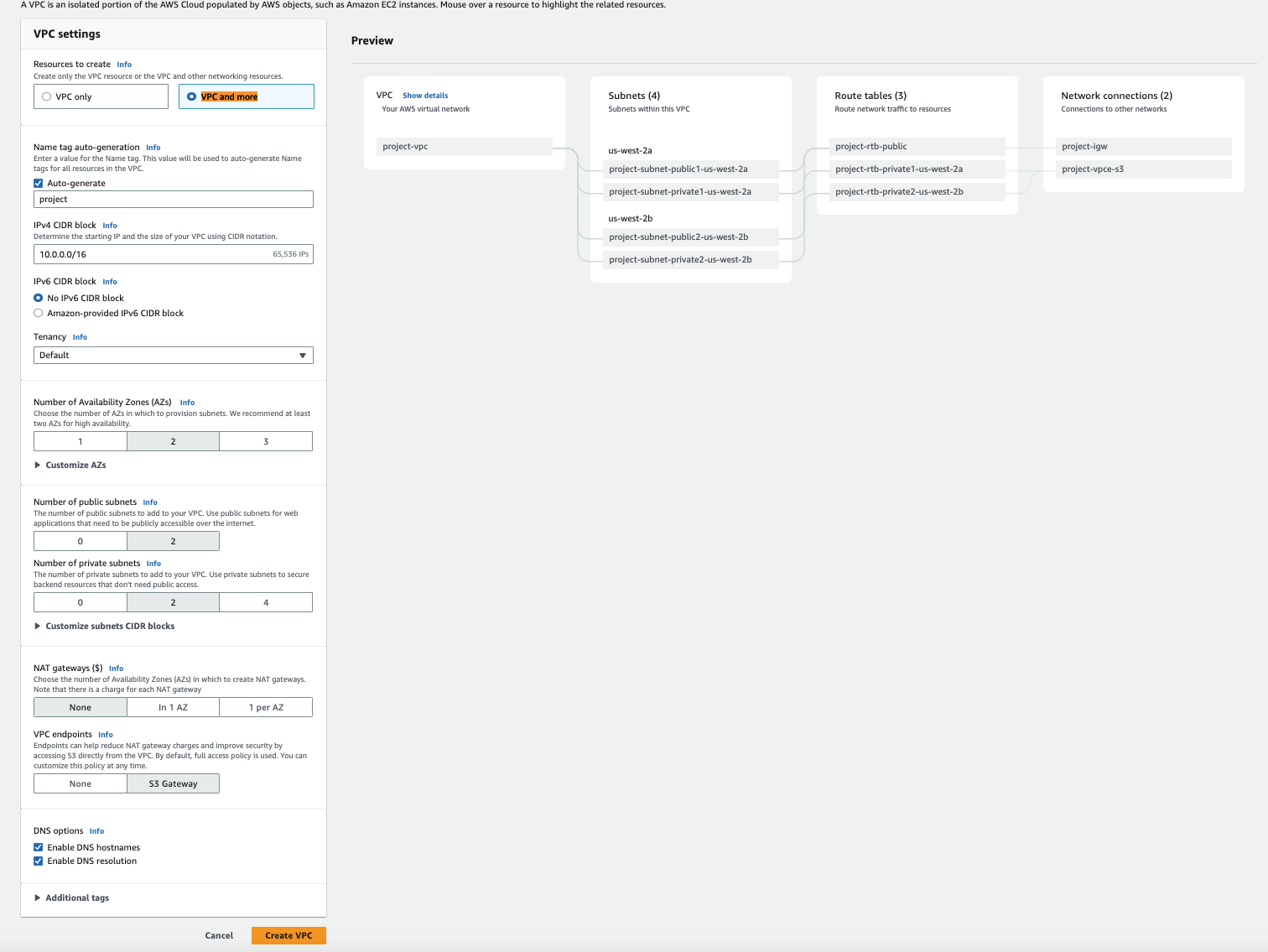
Then we create a security group for the VPC, as shown in the following screenshot.

For more information about the prerequisites, refer to Amazon Athena Google Cloud Storage connector. Additionally, there are tables that highlight the specific data types that can be used such as CSV and Parquet files. There are also required permissions to run the solution.
Google Cloud Platform configuration
To begin, you must have either CSV or Parquet files stored within a GCS bucket. To create the bucket, refer to Create buckets. Make sure to note the bucket name—it will be referenced in a later step. After you create the bucket, upload your objects to the bucket. For instructions, refer to Upload objects from a filesystem.

The CSV data used in this example came from Mockaroo, which generated random test data as shown in the following screenshot. In this example, we use a CSV file, but you can also use Parquet files.

Additionally, you must create a service account to generate a key pair within Google Cloud IAM, which will be uploaded to Secrets Manager. For full instructions, refer to Create service accounts.
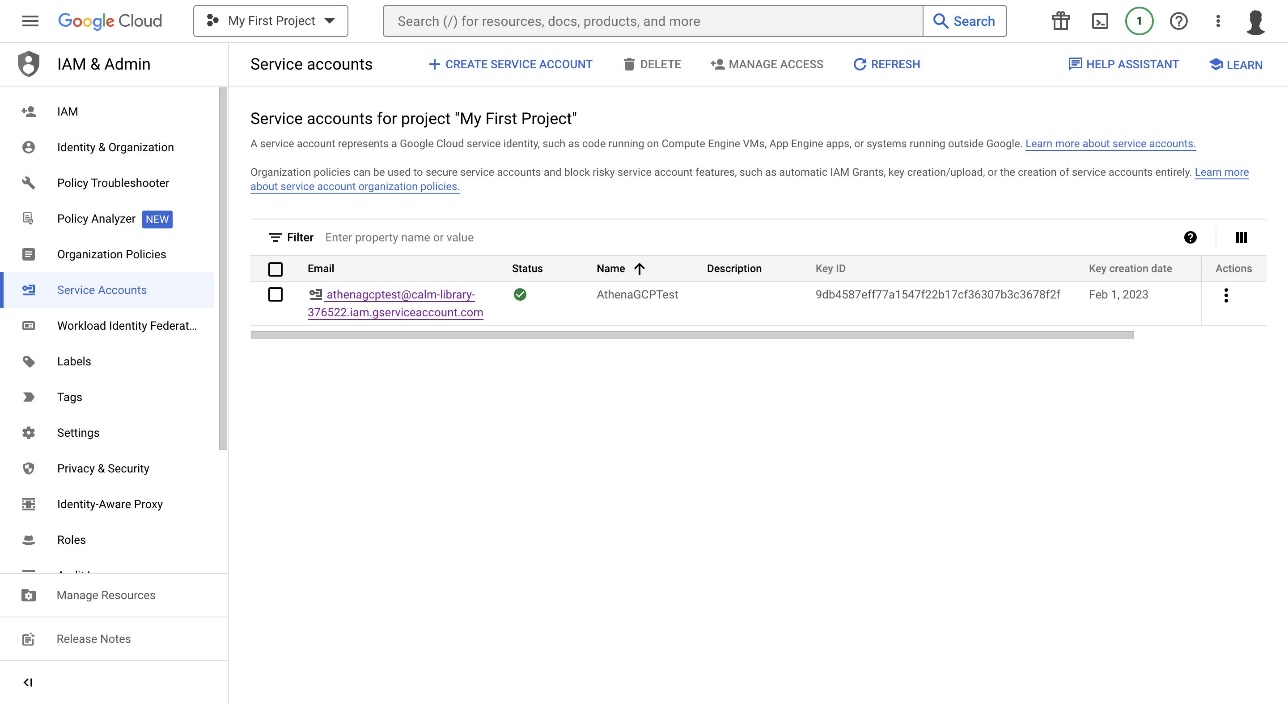
After you create the service account, you can create a key. For instructions, refer to Create and delete service account keys.
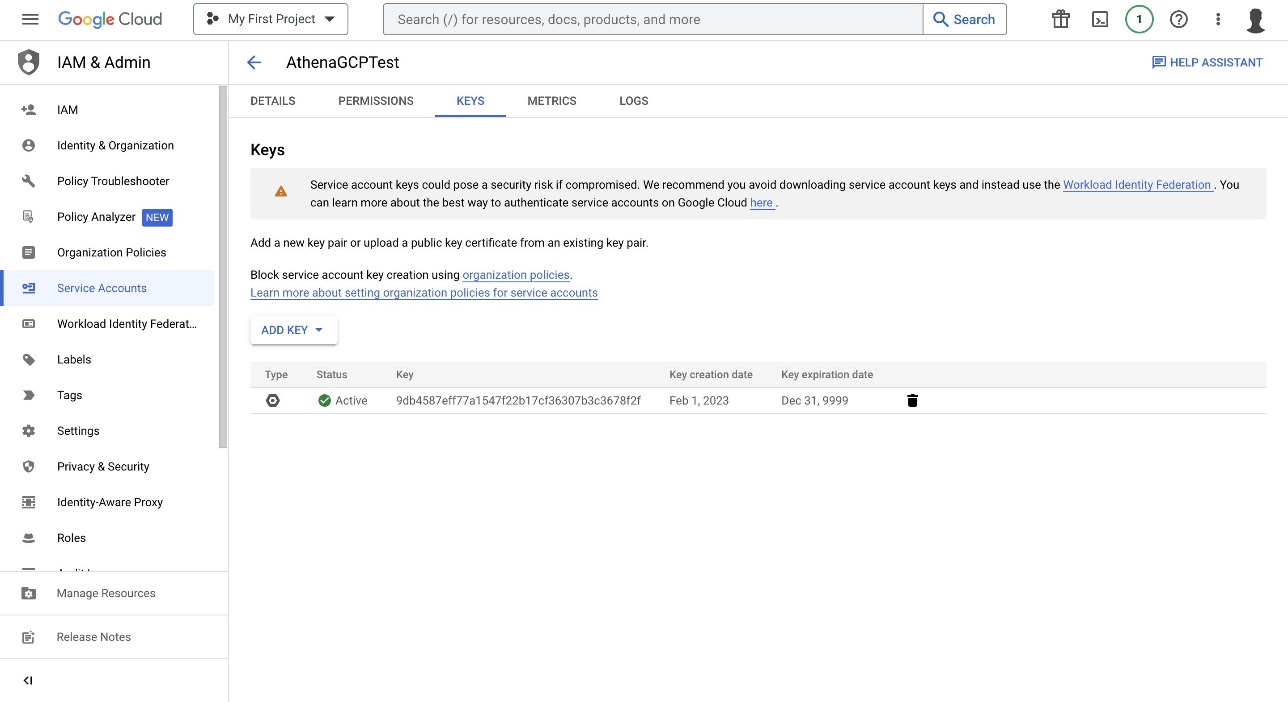
AWS configuration
Now that you have a GCS bucket with a CSV file and a generated JSON key file from Google Cloud Platform, you can proceed with the rest of the steps on AWS.
- On the Secrets Manager console, choose Secrets in the navigation pane.
- Choose Store a new secret and specify Other type of secret.
- Provide the GCP generated key file content.

The next step is to deploy the Athena Google Cloud Storage connector. For more information, refer to Using the Athena console.
- On the Athena console, add a new data source.
- Select Google Cloud Storage.

- For Data source name, enter a name.
- For Lambda function, choose Create Lambda function to be redirected to the Lambda console.

- In the Application settings section, enter the information for Application name, SpillBucket, GCSSecretName, and LambdaFunctionName.
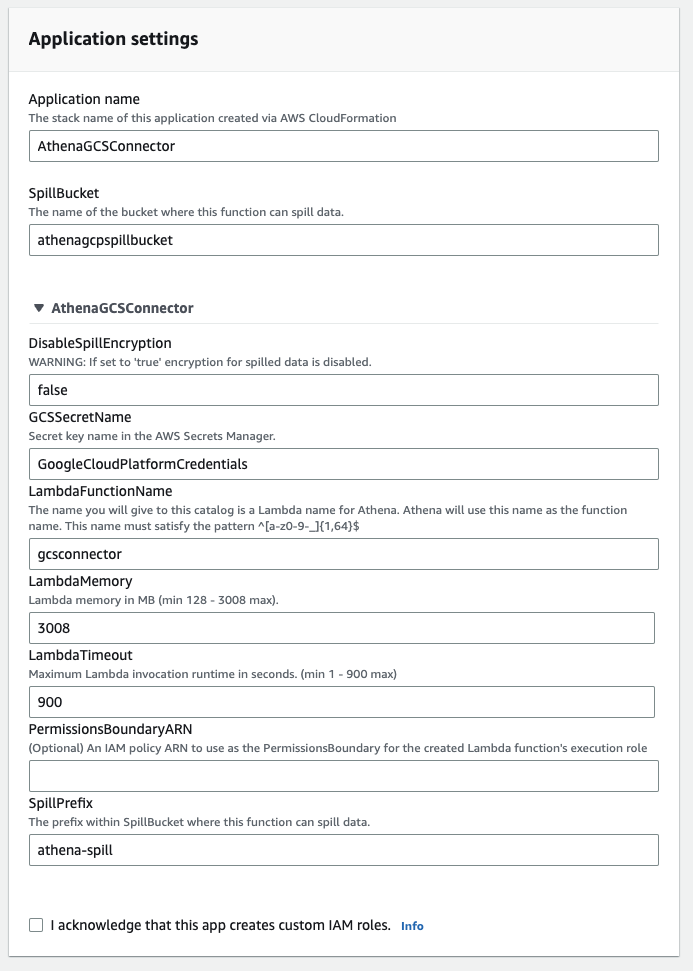
- You also have to create an S3 bucket to reference the S3 spill bucket parameter in order to store data that exceeds the Lambda function’s response size limits. For more information, refer to Create your first S3 bucket.
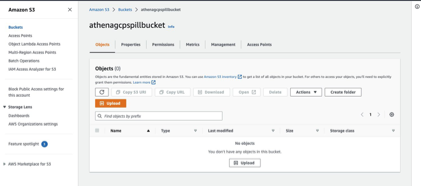
After you provide the Lambda function’s application settings, you’re redirected to the Review and create page.
- Confirm that these are the correct fields and choose Create data source.

Now that the data source connector has been created, you can connect Athena to the data source.
- On the Athena console, navigate to the data source.
- Under Data source details, choose the link for the Lambda function.

You can reference the Lambda function to connect to the data source. As an optional step and for validation, the variables that were put into the Lambda function can be found within the Lambda function’s environment variables on the Configuration tab.

- Because the built-in GCS connector schema inference capability is limited, it’s recommended to create an AWS Glue database and table for your metadata. For instructions, refer to Setting up databases and tables in AWS Glue.
The following screenshot shows our database details.
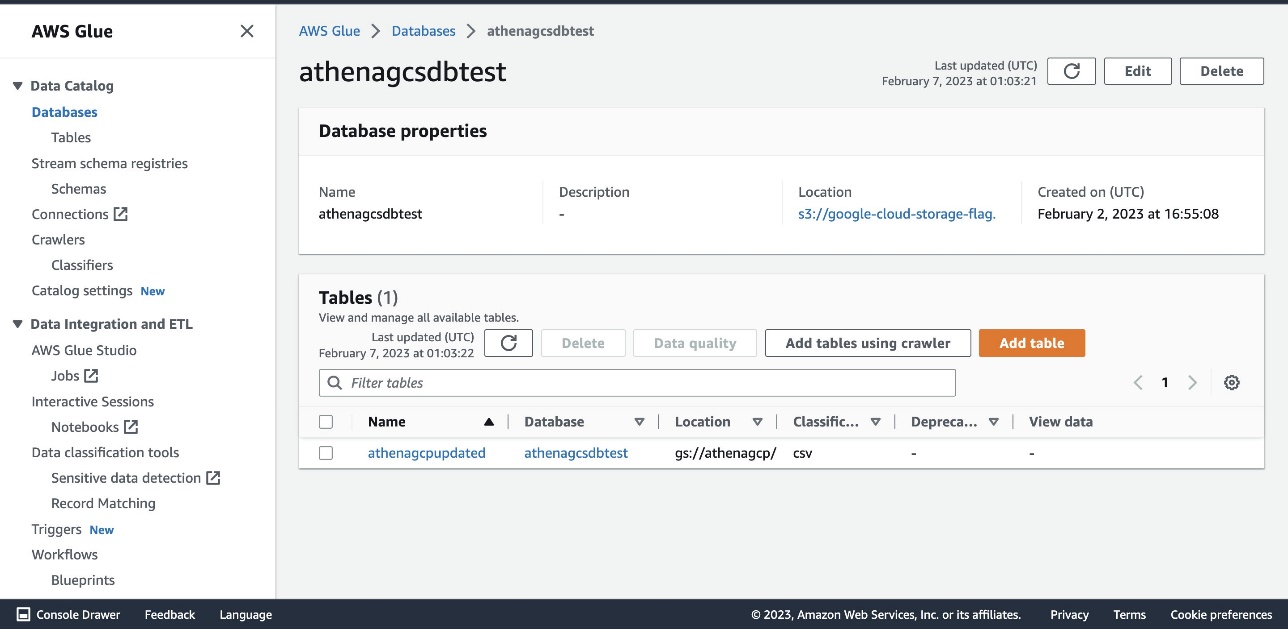
The following screenshot shows our table details.
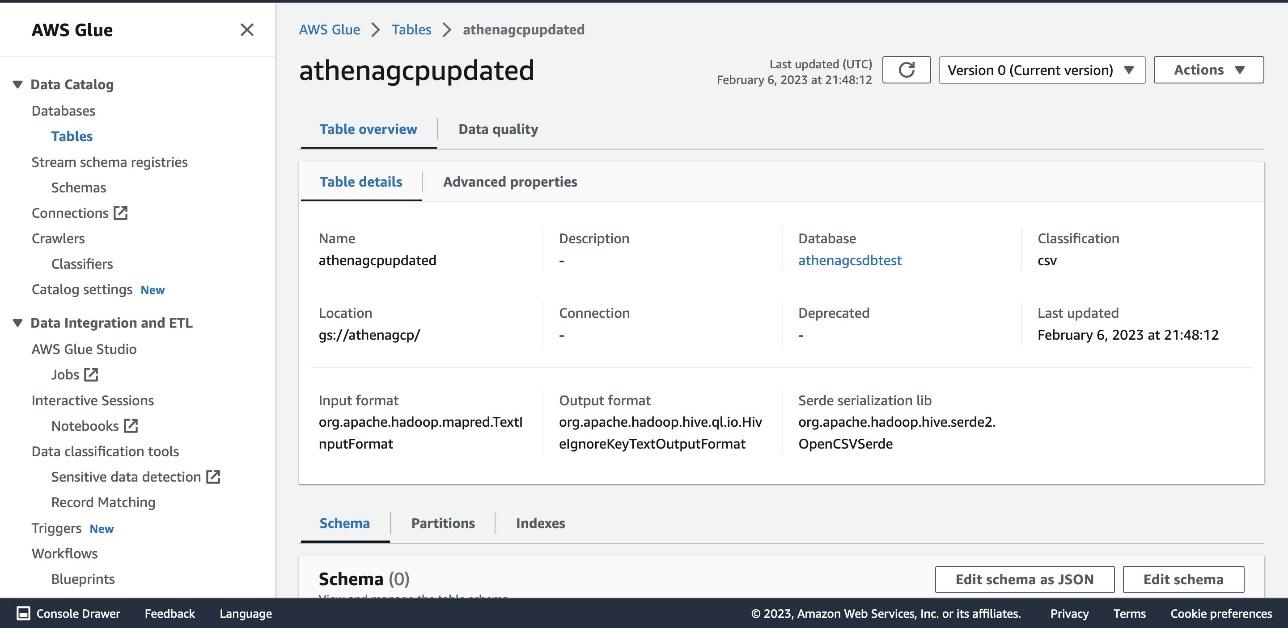
Query the data
Now you can run queries on Athena that will access the data stored on Google Cloud Storage.
- On the Athena console, choose the correct data source, database, and table within the query editor.
- Run
SELECT * FROM [AWS Glue Database name].[AWS Glue Table name]in the query editor.
As shown in the following screenshot, the results will be from the bucket on Google Cloud Storage.

The data that is stored on Google Cloud Platform can be accessed through AWS and used for many use cases, such as performing business intelligence, machine learning, or data science. Doing so can help unblock developers and data scientists so they can efficiently provide results and save time.
Clean up
Complete the following steps to clean up your resources:
- Delete the provisioned bucket in Google Cloud Storage.
- Delete the service account under IAM & Admin.
- Delete the secret GCP credentials in Secrets Manager.
- Delete the S3 spill bucket.
- Delete the Athena connector Lambda function.
- Delete the AWS Glue database and table.
Troubleshooting
If you receive a ROLLBACK_COMPLETE state and “can not be updated error” when creating the data source in Lambda, go to AWS CloudFormation, delete the CloudFormation stack, and try recreating it.
If the AWS Glue table doesn’t appear in the Athena query editor, verify that the data source and database values are correctly selected in the Data pane on the Athena query editor console.
Conclusion
In this post, we saw how you can minimize the time and effort required to access data on Google Cloud Platform and use it efficiently on AWS. Using the data connector helps organizations become multi-cloud agnostic and helps accelerate business growth. Additionally, you can build out BI applications with the discoveries, relationships, and insights found when analyzing the data, which can further your organization’s data analysis process.
About the Author
 Jonathan Wong is a Solutions Architect at AWS assisting with initiatives within Strategic Accounts. He is passionate about solving customer challenges and has been exploring emerging technologies to accelerate innovation.
Jonathan Wong is a Solutions Architect at AWS assisting with initiatives within Strategic Accounts. He is passionate about solving customer challenges and has been exploring emerging technologies to accelerate innovation.
Welcome Chris Opat, Senior Vice President of Cloud Operations
Post Syndicated from Patrick Thomas original https://www.backblaze.com/blog/welcome-chris-opat-senior-vice-president-of-cloud-operations/
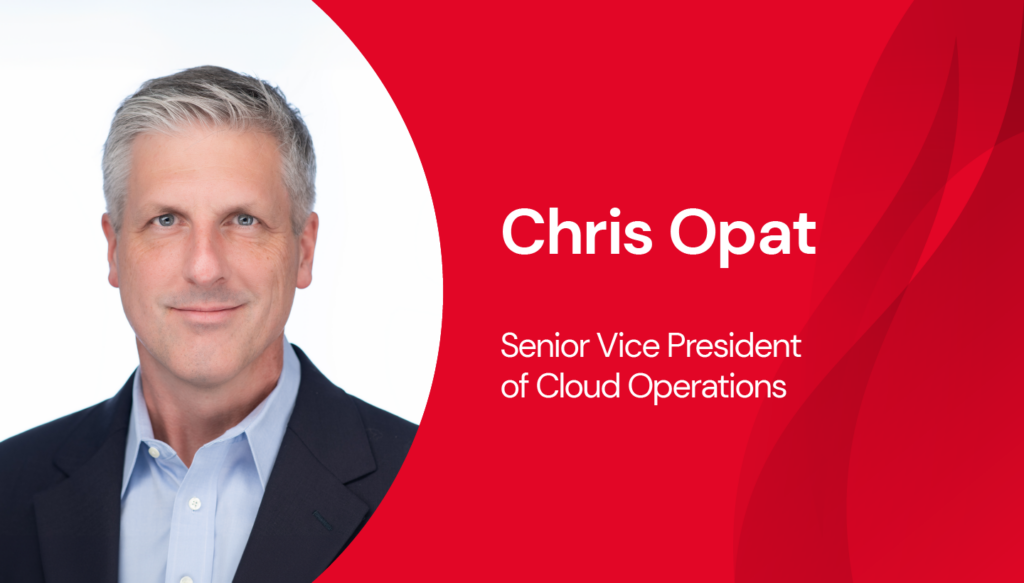
Backblaze is happy to announce that Chris Opat has joined our team as senior vice president of cloud operations. Chris will oversee the strategy and operations of the Backblaze global cloud storage platform.
What Chris Brings to Backblaze
Chris expands the company’s leadership by bringing his impressive cloud and infrastructure knowledge with more than 25 years of industry experience.
Previously, Chris served as senior vice president leading platform engineering and operations at StackPath, a specialized provider in edge technology and content delivery. He also held leadership roles at CyrusOne, CompuCom, Cloudreach, and Bear Stearns/JPMorgan. Chris earned his Bachelor of Science degree in television and digital media production from Ithaca College.
Backblaze CEO, Gleb Budman, shared that Chris is a forward-thinking cloud leader with a proven track record of leading teams that are clever and bold in solving problems and creating best-in-class experiences for customers. His expertise and approach will be pivotal as more customers move to an open cloud ecosystem and will help advance Backblaze’s cloud strategy as we continue to grow.
Chris’ Role as SVP of Cloud Operations
As SVP of Cloud Operations, Chris oversees cloud strategy, platform engineering, and technology infrastructure, enabling Backblaze to further scale capacity and improve performance to meet larger-sized customers’ needs, as we continue to see success in moving up-market.
Chris says of his new role at Backblaze:
Backblaze’s vision and mission resonate with me. I’m proud to be joining a company that is supporting customers and advocating for an open cloud ecosystem. I’m looking forward to working with the amazing team at Backblaze as we continue to scale with our customers and accelerate growth.
The post Welcome Chris Opat, Senior Vice President of Cloud Operations appeared first on Backblaze Blog | Cloud Storage & Cloud Backup.
Integrating IBM MQ with Amazon SQS and Amazon SNS using Apache Camel
Post Syndicated from Pascal Vogel original https://aws.amazon.com/blogs/compute/integrating-ibm-mq-with-amazon-sqs-and-amazon-sns-using-apache-camel/
This post is written by Joaquin Rinaudo, Principal Security Consultant and Gezim Musliaj, DevOps Consultant.
IBM MQ is a message-oriented middleware (MOM) product used by many enterprise organizations, including global banks, airlines, and healthcare and insurance companies.
Customers often ask us for guidance on how they can integrate their existing on-premises MOM systems with new applications running in the cloud. They’re looking for a cost-effective, scalable and low-effort solution that enables them to send and receive messages from their cloud applications to these messaging systems.
This blog post shows how to set up a bi-directional bridge from on-premises IBM MQ to Amazon MQ, Amazon Simple Queue Service (Amazon SQS), and Amazon Simple Notification Service (Amazon SNS).
This allows your producer and consumer applications to integrate using fully managed AWS messaging services and Apache Camel. Learn how to deploy such a solution and how to test the running integration using SNS, SQS, and a demo IBM MQ cluster environment running on Amazon Elastic Container Service (ECS) with AWS Fargate.
This solution can also be used as part of a step-by-step migration using the approach described in the blog post Migrating from IBM MQ to Amazon MQ using a phased approach.
Solution overview
The integration consists of an Apache Camel broker cluster that bi-directionally integrates an IBM MQ system and target systems, such as Amazon MQ running ActiveMQ, SNS topics, or SQS queues.
In the following example, AWS services, in this case AWS Lambda and SQS, receive messages published to IBM MQ via an SNS topic:
- The cloud message consumers (Lambda and SQS) subscribe to the solution’s target SNS topic.
- The Apache Camel broker connects to IBM MQ using secrets stored in AWS Secrets Manager and reads new messages from the queue using IBM MQ’s Java library. Only IBM MQ messages are supported as a source.
- The Apache Camel broker publishes these new messages to the target SNS topic. It uses the Amazon SNS Extended Client Library for Java to store any messages larger than 256 KB in an Amazon Simple Storage Service (Amazon S3) bucket.
- Apache Camel stores any message that cannot be delivered to SNS after two retries in an S3 dead letter queue bucket.
The next diagram demonstrates how the solution sends messages back from an SQS queue to IBM MQ:
- A sample message producer using Lambda sends messages to an SQS queue. It uses the Amazon SQS Extended Client Library for Java to send messages larger than 256 KB.
- The Apache Camel broker receives the messages published to SQS, using the SQS Extended Client Library if needed.
- The Apache Camel broker sends the message to the IBM MQ target queue.
- As before, the broker stores messages that cannot be delivered to IBM MQ in the S3 dead letter queue bucket.
A phased live migration consists of two steps:
- Deploy the broker service to allow reading messages from and writing to existing IBM MQ queues.
- Once the consumer or producer is migrated, migrate its counterpart to the newly selected service (SNS or SQS).
Next, you will learn how to set up the solution using the AWS Cloud Development Kit (AWS CDK).
Deploying the solution
Prerequisites
- AWS CDK
- TypeScript
- Java
- Docker
- Git
- Yarn
Step 1: Cloning the repository
Clone the repository using git:
git clone https://github.com/aws-samples/aws-ibm-mq-adapterStep 2: Setting up test IBM MQ credentials
This demo uses IBM MQ’s mutual TLS authentication. To do this, you must generate X.509 certificates and store them in AWS Secrets Manager by running the following commands in the app folder:
- Generate X.509 certificates:
./deploy.sh generate_secrets - Set up the secrets required for the Apache Camel broker (replace
<integration-name>with, for example,dev):./deploy.sh create_secrets broker <integration-name> - Set up secrets for the mock IBM MQ system:
./deploy.sh create_secrets mock - Update the
cdk.jsonfile with the secrets ARN output from the previous commands:IBM_MOCK_PUBLIC_CERT_ARNIBM_MOCK_PRIVATE_CERT_ARNIBM_MOCK_CLIENT_PUBLIC_CERT_ARNIBMMQ_TRUSTSTORE_ARNIBMMQ_TRUSTSTORE_PASSWORD_ARNIBMMQ_KEYSTORE_ARNIBMMQ_KEYSTORE_PASSWORD_ARN
If you are using your own IBM MQ system and already have X.509 certificates available, you can use the script to upload those certificates to AWS Secrets Manager after running the script.
Step 3: Configuring the broker
The solution deploys two brokers, one to read messages from the test IBM MQ system and one to send messages back. A separate Apache Camel cluster is used per integration to support better use of Auto Scaling functionality and to avoid issues across different integration operations (consuming and reading messages).
Update the cdk.json file with the following values:
accountId: AWS account ID to deploy the solution to.region: name of the AWS Region to deploy the solution to.defaultVPCId: specify a VPC ID for an existing VPC in the AWS account where the broker and mock are deployed.allowedPrincipals: add your account ARN (e.g.,arn:aws:iam::123456789012:root) to allow this AWS account to send messages to and receive messages from the broker. You can use this parameter to set up cross-account relationships for both SQS and SNS integrations and support multiple consumers and producers.
Step 4: Bootstrapping and deploying the solution
- Make sure you have the correct
AWS_PROFILEandAWS_REGIONenvironment variables set for your development account. - Run
yarn cdk bootstrap –-qualifier mq <aws://<account-id>/<region>to bootstrap CDK. - Run
yarn installto install CDK dependencies. - Finally, execute
yarn cdk deploy '*-dev' –-qualifier mq --require-approval neverto deploy the solution to thedevenvironment.
Step 5: Testing the integrations
Use AWS System Manager Session Manager and port forwarding to establish tunnels to the test IBM MQ instance to access the web console and send messages manually. For more information on port forwarding, see Amazon EC2 instance port forwarding with AWS System Manager.
- In a command line terminal, make sure you have the correct
AWS_PROFILEandAWS_REGIONenvironment variables set for your development account. - In addition, set the following environment variables:
IBM_ENDPOINT: endpoint for IBM MQ. Example: network load balancer for IBM mockmqmoc-mqada-1234567890.elb.eu-west-1.amazonaws.com.BASTION_ID: instance ID for the bastion host. You can retrieve this output from Step 4: Bootstrapping and deploying the solution listed after themqBastionStackdeployment.
Use the following command to set the environment variables:
export IBM_ENDPOINT=mqmoc-mqada-1234567890.elb.eu-west-1.amazonaws.com export BASTION_ID=i-0a1b2c3d4e5f67890 - Run the script
test/connect.sh. - Log in to the IBM web console via
https://127.0.0.1:9443/adminusing the default IBM user (admin) and the password stored in AWS Secrets Manager asmqAdapterIbmMockAdminPassword.
Sending data from IBM MQ and receiving it in SNS:
- In the IBM MQ console, access the local queue manager
QM1andDEV.QUEUE.1. - Send a message with the content
Hello AWS. This message will be processed by AWS Fargate and published to SNS. - Access the SQS console and choose the
snsIntegrationStack-dev-2prefix queue. This is an SQS queue subscribed to the SNS topic for testing. - Select Send and receive message.
- Select Poll for messages to see the
Hello AWSmessage previously sent to IBM MQ.
Sending data back from Amazon SQS to IBM MQ:
- Access the SQS console and choose the queue with the prefix
sqsPublishIntegrationStack-dev-3-dev. - Select Send and receive messages.
- For Message Body, add
Hello from AWS. - Choose Send message.
- In the IBM MQ console, access the local queue manager
QM1andDEV.QUEUE.2to find your message listed under this queue.
Step 6: Cleaning up
Run cdk destroy '*-dev' to destroy the resources deployed as part of this walkthrough.
Conclusion
In this blog, you learned how you can exchange messages between IBM MQ and your cloud applications using Amazon SQS and Amazon SNS.
If you’re interested in getting started with your own integration, follow the README file in the GitHub repository. If you’re migrating existing applications using industry-standard APIs and protocols such as JMS, NMS, or AMQP 1.0, consider integrating with Amazon MQ using the steps provided in the repository.
If you’re interested in running Apache Camel in Kubernetes, you can also adapt the architecture to use Apache Camel K instead.
For more serverless learning resources, visit Serverless Land.
Maintainers Summit call for topics
Post Syndicated from corbet original https://lwn.net/Articles/941660/
The 2023 Maintainers Summit will be held on November 16 in Richmond, VA,
immediately after the Linux Plumbers
Conference.
As in previous years, the Maintainers Summit is invite-only, where
the primary focus will be process issues around Linux Kernel
Development. It will be limited to 30 invitees and a handful of
sponsored attendees.
The call for
topics has just gone out, with the first invitations to be sent within
a couple of weeks or so.
Security updates for Tuesday
Post Syndicated from corbet original https://lwn.net/Articles/941658/
Security updates have been issued by Debian (samba), Red Hat (.NET 6.0, .NET 7.0, rh-dotnet60-dotnet, rust, rust-toolset-1.66-rust, and rust-toolset:rhel8), and SUSE (kernel and opensuse-welcome).
THG Podcast: Age of Airships
Post Syndicated from The History Guy: History Deserves to Be Remembered original https://www.youtube.com/watch?v=JRq4KnsfO7I
Digital making with Raspberry Pis in primary schools in Sarawak, Malaysia
Post Syndicated from Jenni Fletcher-McGrady original https://www.raspberrypi.org/blog/computing-education-primary-schools-sarawak-malaysia/
Dr Sue Sentance, Director of our Raspberry Pi Computing Education Research Centre at the University of Cambridge, shares what she learned on a recent visit in Malaysia to understand more about the approach taken to computing education in the state of Sarawak.

Computing education is a challenge around the world, and it is fascinating to see how different countries and education systems approach it. I recently had the opportunity to attend an event organised by the government of Sarawak, Malaysia, to see first-hand what learners and teachers are achieving thanks to the state’s recent policies.
Raspberry Pis and training for Sarawak’s primary schools
In Sarawak, the largest state of Malaysia, the local Ministry of Education, Innovation and Talent Development is funding an ambitious project through which all of Sarawak’s primary schools are receiving sets of Raspberry Pis. Learners use these as desktop computers and to develop computer science skills and knowledge, including the skills to create digital making projects.
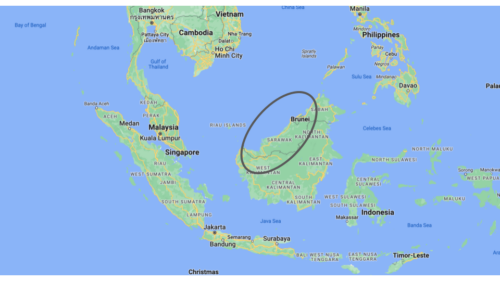
Crucially, the ministry is combining this hardware distribution initiative with a three-year programme of professional development for primary school teachers. They receive training known as the Raspberry Pi Training Programme, which starts with Scratch programming and incorporates elements of physical computing with the Raspberry Pis and sensors.
To date the project has provided 9436 kits (including Raspberry Pi computer, case, monitor, mouse, and keyboard) to schools, and training for over 1200 teachers.
The STEM Trailblazers event
In order to showcase what has been achieved through the project so far, students and teachers were invited to use their schools’ Raspberry Pis to create projects to prototype solutions to real problems faced by their communities, and to showcase these projects at a special STEM Trailblazers event.

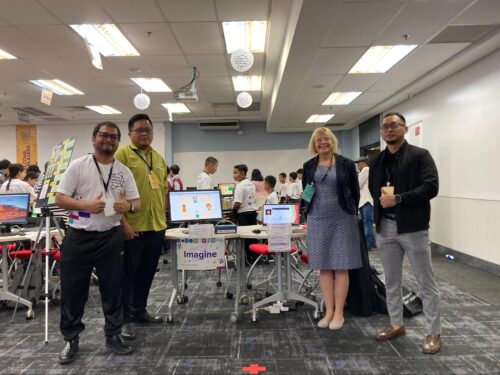
Geographically, Sarawak is Malaysia’s largest state, but it has a much smaller population than the west of the country. This means that towns and villages are very spread out and teachers and students had large distances to travel to attend the STEM Trailblazers event. To partially address this, the event was held in two locations simultaneously, Kuching and Miri, and talks were live-streamed between both venues.
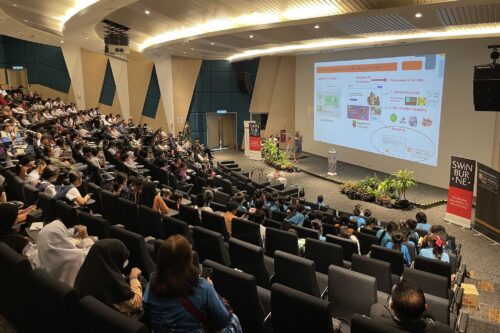
STEM Trailblazers featured a host of talks from people involved in the initiative. I was very honoured to be invited as a guest speaker, representing both the University of Cambridge and the Raspberry Pi Foundation as the Director of the Raspberry Pi Computing Education Research Centre.
Solving real-world problems
The Raspberry Pi projects at STEM Trailblazers were entered into a competition, with prizes for students and teachers. Most projects had been created using Scratch to control the Raspberry Pi as well as a range of sensors.
The children and teachers who participated came from both rural and urban areas, and it was clear that the issues they had chosen to address were genuine problems in their communities.
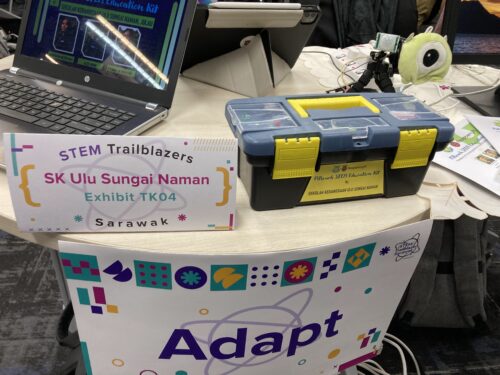
Many of the projects I saw related to issues that schools faced around heat and hydration: a Smart Bottle project reminded children to drink regularly, a shade creator project created shade when the temperature got too high, a teachers’ project told students that they could no longer play outside when the temperature exceeded 35 degrees, and a water cooling system project set off sprinklers when the temperature rose. Other themes of the projects were keeping toilets clean, reminding children to eat healthily, and helping children to learn the alphabet. One project that especially intrigued me was an alert system for large and troublesome birds that were a problem for rural schools.

The creativity and quality of the projects on show was impressive given that all the students (and many of their teachers) had learned to program very recently, and also had to be quite innovative where they hadn’t been able to access all the hardware they needed to build their creations.
What we can learn from this initiative
Everyone involved in this project in Sarawak — including teachers, government representatives, university academics, and industry partners — is really committed to giving children the best opportunities to grow up with an understanding of digital technology. They know this is essential for their professional futures, and also fosters their creativity, independence, and problem-solving skills.
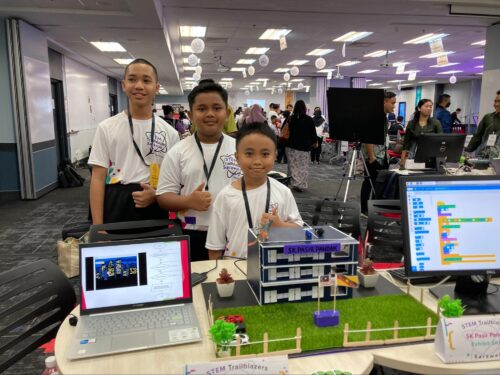
Over the last ten years, I’ve been fortunate enough to travel widely in my capacity as a computing education researcher, and I’ve seen first-hand a number of the approaches countries are taking to help their young people gain the skills and understanding of computing technologies that they need for their futures.
It’s good for us to look beyond our own context to understand how countries across the world are preparing their young people to engage with digital technology. No matter how many similarities there are between two places, we can all learn from each other’s initiatives and ideas. In 2021 the Brookings Institution published a global review of how countries are progressing with this endeavour. Organisations such as UNESCO and WEF regularly publish reports that emphasise the importance for countries to develop their citizens’ digital skills, and also advanced technological skills.

The Sarawak government’s initiative is grounded in the use of Raspberry Pis as desktop computers for schools, which run offline where schools have no access to the internet. That teachers are also trained to use the Raspberry Pis to support learners to develop hands-on digital making skills is a really important aspect of the project.
Our commercial subsidiary Raspberry Pi Limited works with a company network of Approved Resellers around the globe; in this case the Malaysian reseller Cytron has been an enormous support in supplying Sarawak’s primary schools with Raspberry Pis and other hardware.
Schools anywhere in the world can also access the Raspberry Pi Foundation’s free learning and teaching resources, such as curriculum materials, online training courses for teachers, and our magazine for educators, Hello World. We are very proud to support the work being done in Sarawak.
As for what the future holds for Sarawak’s computing education, at the opening ceremony of the STEM Trailblazers event, the Deputy Minister announced that the event will be an annual occasion. That means every year more students and teachers will be able to come together, share their learning, and get excited about using digital making to solve the problems that matter to them.
The post Digital making with Raspberry Pis in primary schools in Sarawak, Malaysia appeared first on Raspberry Pi Foundation.
Zoom Can Spy on Your Calls and Use the Conversation to Train AI, But Says That It Won’t
Post Syndicated from Bruce Schneier original https://www.schneier.com/blog/archives/2023/08/zoom-can-spy-on-your-calls-and-use-the-conversation-to-train-ai-but-says-that-it-wont.html
This is why we need regulation:
Zoom updated its Terms of Service in March, spelling out that the company reserves the right to train AI on user data with no mention of a way to opt out. On Monday, the company said in a blog post that there’s no need to worry about that. Zoom execs swear the company won’t actually train its AI on your video calls without permission, even though the Terms of Service still say it can.
Of course, these are Terms of Service. They can change at any time. Zoom can renege on its promise at any time. There are no rules, only the whims of the company as it tries to maximize its profits.
It’s a stupid way to run a technological revolution. We should not have to rely on the benevolence of for-profit corporations to protect our rights. It’s not their job, and it shouldn’t be.
Comic for 2023.08.15 – It’s A Boy
Post Syndicated from Explosm.net original https://explosm.net/comics/its-a-boy
New Cyanide and Happiness Comic
Streamlining Grab’s Segmentation Platform with faster creation and lower latency
Post Syndicated from Grab Tech original https://engineering.grab.com/streamlining-grabs-segmentation-platform
Launched in 2019, Segmentation Platform has been Grab’s one-stop platform for user segmentation and audience creation across all business verticals. User segmentation is the process of dividing passengers, driver-partners, or merchant-partners (users) into sub-groups (segments) based on certain attributes. Segmentation Platform empowers Grab’s teams to create segments using attributes available within our data ecosystem and provides APIs for downstream teams to retrieve them.
Checking whether a user belongs to a segment (Membership Check) influences many critical flows on the Grab app:
- When a passenger launches the Grab app, our in-house experimentation platform will tailor the app experience based on the segments the passenger belongs to.
- When a driver-partner goes online on the Grab app, the Drivers service calls Segmentation Platform to ensure that the driver-partner is not blacklisted.
- When launching marketing campaigns, Grab’s communications platform relies on Segmentation Platform to determine which passengers, driver-partners, or merchant-partners to send communication to.
This article peeks into the current design of Segmentation Platform and how the team optimised the way segments are stored to reduce read latency thus unlocking new segmentation use cases.
Architecture
Segmentation Platform comprises two major subsystems:
- Segment creation
- Segment serving

Segment creation
Segment creation is powered by Spark jobs. When a Grab team creates a segment, a Spark job is started to retrieve data from our data lake. After the data is retrieved, cleaned, and validated, the Spark job calls the serving sub-system to populate the segment with users.
Segment serving
Segment serving is powered by a set of Go services. For persistence and serving, we use ScyllaDB as our primary storage layer. We chose to use ScyllaDB as our NoSQL store due to its ability to scale horizontally and meet our <80ms p99 SLA. Users in a segment are stored as rows indexed by the user ID. The table is partitioned by the user ID ensuring that segment data is evenly distributed across the ScyllaDB clusters.
| User ID | Segment Name | Other metadata columns |
|---|---|---|
| 1221 | Segment_A | … |
| 3421 | Segment_A | … |
| 5632 | Segment_B | … |
| 7889 | Segment_B | … |
With this design, Segmentation Platform handles up to 12K read and 36K write QPS, with a p99 latency of 40ms.
Problems
The existing system has supported Grab, empowering internal teams to create rich and personalised experiences. However, with the increased adoption and use, certain challenges began to emerge:
- As more and larger segments are being created, the write QPS became a bottleneck leading to longer wait times for segment creation.
- Grab services requested even lower latency for membership checks.
Long segment creation times
As more segments were created by different teams within Grab, the write QPS was no longer able to keep up with the teams’ demands. Teams would have to wait for hours for their segments to be created, reducing their operational velocity.
Read latency
Further, while the platform already offers sub-40ms p99 latency for reads, this was still too slow for certain services and their use cases. For example, Grab’s communications platform needed to check whether a user belongs to a set of segments before sending out communication and incurring increased latency for every communication request was not acceptable. Another use case was for Experimentation Platform, where checks must have low latency to not impact the user experience.
Thus, the team explored alternative ways of storing the segment data with the goals of:
- Reducing segment creation time
- Reducing segment read latency
- Maintaining or reducing cost
Solution
Segments as bitmaps
One of the main engineering challenges was scaling the write throughput of the system to keep pace with the number of segments being created. As a segment is stored across multiple rows in ScyllaDB, creating a large segment incurs a huge number of writes to the database. What we needed was a better way to store a large set of user IDs. Since user IDs are represented as integers in our system, a natural solution to storing a set of integers was a bitmap.
For example, a segment containing the following user IDs: 1, 6, 25, 26, 89 could be represented with a bitmap as follows:

To perform a membership check, a bitwise operation can be used to check if the bit at the user ID’s index is 0 or 1. As a bitmap, the segment can also be stored as a single Blob in object storage instead of inside ScyllaDB.
However, as the number of user IDs in the system is large, a small and sparse segment would lead to prohibitively large bitmaps. For example, if a segment contains 2 user IDs 100 and 200,000,000, it will require a bitmap containing 200 million bits (25MB) where all but 2 of the bits are just 0. Thus, the team needed an encoding to handle sparse segments more efficiently.
Roaring Bitmaps
After some research, we landed on Roaring Bitmaps, which are compressed uint32 bitmaps. With roaring bitmaps, we are able to store a segment with 1 million members in a Blob smaller than 1 megabyte, compared to 4 megabytes required by a naive encoding.
Roaring Bitmaps achieve good compression ratios by splitting the set into fixed-size (216) integer chunks and using three different data structures (containers) based on the data distribution within the chunk. The most significant 16 bits of the integer are used as the index of the chunk, and the least significant 16 bits are stored in the containers.
Array containers
Array containers are used when data is sparse (<= 4096 values). An array container is a sorted array of 16-bit integers. It is memory-efficient for sparse data and provides logarithmic-time access.
Bitmap containers
Bitmap containers are used when data is dense. A bitmap container is a 216 bit container where each bit represents the presence or absence of a value. It is memory-efficient for dense data and provides constant-time access.
Run containers
Finally, run containers are used when a chunk has long consecutive values. Run containers use run-length encoding (RLE) to reduce the storage required for dense bitmaps. Run containers store a pair of values representing the start and the length of the run. It provides good memory efficiency and fast lookups.
The diagram below shows how a dense bitmap container that would have required 91 bits can be compressed into a run container by storing only the start (0) and the length (90). It should be noted that run containers are used only if it reduces the number of bytes required compared to a bitmap.

By using different containers, Roaring Bitmaps are able to achieve good compression across various data distributions, while maintaining excellent lookup performance. Additionally, as segments are represented as Roaring Bitmaps, service teams are able to perform set operations (union, interaction, and difference, etc) on the segments on the fly, which previously required re-materialising the combined segment into the database.
Caching with an SDK
Even though the segments are now compressed, retrieving a segment from the Blob store for each membership check would incur an unacceptable latency penalty. To mitigate the overhead of retrieving a segment, we developed an SDK that handles the retrieval and caching of segments.

The SDK takes care of the retrieval, decoding, caching, and watching of segments. Users of the SDK are only required to specify the maximum size of the cache to prevent exhausting the service’s memory. The SDK provides a cache with a least-recently-used eviction policy to ensure that hot segments are kept in the cache. They are also able to watch for updates on a segment and the SDK will automatically refresh the cached segment when it is updated.
Hero teams
Communications Platform
Communications Platform has adopted the SDK to implement a new feature to control the communication frequency based on which segments a user belongs to. Using the SDK, the team is able to perform membership checks on multiple multi-million member segments, achieving peak QPS 15K/s with a p99 latency of <1ms. With the new feature, they have been able to increase communication engagement and reduce the communication unsubscribe rate.
Experimentation Platform
Experimentation Platform powers experimentation across all Grab services. Segments are used heavily in experiments to determine a user’s experience. Prior to using the SDK, Experimentation Platform limited the maximum size of the segments that could be used to prevent exhausting a service’s memory.
After migrating to the new SDK, they were able to lift this restriction due to the compression efficiency of Roaring Bitmaps. Users are now able to use any segments as part of their experiment without worrying that it would require too much memory.
Closing
This blog post discussed the challenges that Segmentation Platform faced when scaling and how the team explored alternative storage and encoding techniques to improve segment creation time, while also achieving low latency reads. The SDK allows our teams to easily make use of segments without having to handle the details of caching, eviction, and updating of segments.
Moving forward, there are still existing use cases that are not able to use the Roaring Bitmap segments and thus continue to rely on segments from ScyllaDB. Therefore, the team is also taking steps to optimise and improve the scalability of our service and database.
Special thanks to Axel, the wider Segmentation Platform team, and Data Technology team for reviewing the post.
Join us
Grab is the leading superapp platform in Southeast Asia, providing everyday services that matter to consumers. More than just a ride-hailing and food delivery app, Grab offers a wide range of on-demand services in the region, including mobility, food, package and grocery delivery services, mobile payments, and financial services across 428 cities in eight countries.
Powered by technology and driven by heart, our mission is to drive Southeast Asia forward by creating economic empowerment for everyone. If this mission speaks to you, join our team today!
Why Can’t We Quit Weddings?
Post Syndicated from The Atlantic original https://www.youtube.com/watch?v=7hTz9q9ai3c
Implementing automatic drift detection in CDK Pipelines using Amazon EventBridge
Post Syndicated from DAMODAR SHENVI WAGLE original https://aws.amazon.com/blogs/devops/implementing-automatic-drift-detection-in-cdk-pipelines-using-amazon-eventbridge/
The AWS Cloud Development Kit (AWS CDK) is a popular open source toolkit that allows developers to create their cloud infrastructure using high level programming languages. AWS CDK comes bundled with a construct called CDK Pipelines that makes it easy to set up continuous integration, delivery, and deployment with AWS CodePipeline. The CDK Pipelines construct does all the heavy lifting, such as setting up appropriate AWS IAM roles for deployment across regions and accounts, Amazon Simple Storage Service (Amazon S3) buckets to store build artifacts, and an AWS CodeBuild project to build, test, and deploy the app. The pipeline deploys a given CDK application as one or more AWS CloudFormation stacks.
With CloudFormation stacks, there is the possibility that someone can manually change the configuration of stack resources outside the purview of CloudFormation and the pipeline that deploys the stack. This causes the deployed resources to be inconsistent with the intent in the application, which is referred to as “drift”, a situation that can make the application’s behavior unpredictable. For example, when troubleshooting an application, if the application has drifted in production, it is difficult to reproduce the same behavior in a development environment. In other cases, it may introduce security vulnerabilities in the application. For example, an AWS EC2 SecurityGroup that was originally deployed to allow ingress traffic from a specific IP address might potentially be opened up to allow traffic from all IP addresses.
CloudFormation offers a drift detection feature for stacks and stack resources to detect configuration changes that are made outside of CloudFormation. The stack/resource is considered as drifted if its configuration does not match the expected configuration defined in the CloudFormation template and by extension the CDK code that synthesized it.
In this blog post you will see how CloudFormation drift detection can be integrated as a pre-deployment validation step in CDK Pipelines using an event driven approach.
Services and frameworks used in the post include CloudFormation, CodeBuild, Amazon EventBridge, AWS Lambda, Amazon DynamoDB, S3, and AWS CDK.
Solution overview
Amazon EventBridge is a serverless AWS service that offers an agile mechanism for the developers to spin up loosely coupled, event driven applications at scale. EventBridge supports routing of events between services via an event bus. EventBridge out of the box supports a default event bus for each account which receives events from AWS services. Last year, CloudFormation added a new feature that enables event notifications for changes made to CloudFormation-based stacks and resources. These notifications are accessible through Amazon EventBridge, allowing users to monitor and react to changes in their CloudFormation infrastructure using event-driven workflows. Our solution leverages the drift detection events that are now supported by EventBridge. The following architecture diagram depicts the flow of events involved in successfully performing drift detection in CDK Pipelines.

Architecture diagram
The user starts the pipeline by checking code into an AWS CodeCommit repo, which acts as the pipeline source. We have configured drift detection in the pipeline as a custom step backed by a lambda function. When the drift detection step invokes the provider lambda function, it first starts the drift detection on the CloudFormation stack Demo Stack and then saves the drift_detection_id along with pipeline_job_id in a DynamoDB table. In the meantime, the pipeline waits for a response on the status of drift detection.
The EventBridge rules are set up to capture the drift detection state change events for Demo Stack that are received by the default event bus. The callback lambda is registered as the intended target for the rules. When drift detection completes, it triggers the EventBridge rule which in turn invokes the callback lambda function with stack status as either DRIFTED or IN SYNC. The callback lambda function pulls the pipeline_job_id from DynamoDB and sends the appropriate status back to the pipeline, thus propelling the pipeline out of the wait state. If the stack is in the IN SYNC status, the callback lambda sends a success status and the pipeline continues with the deployment. If the stack is in the DRIFTED status, callback lambda sends failure status back to the pipeline and the pipeline run ends up in failure.
Solution Deep Dive
The solution deploys two stacks as shown in the above architecture diagram
- CDK Pipelines stack
- Pre-requisite stack
The CDK Pipelines stack defines a pipeline with a CodeCommit source and drift detection step integrated into it. The pre-requisite stack deploys following resources that are required by the CDK Pipelines stack.
- A Lambda function that implements drift detection step
- A DynamoDB table that holds
drift_detection_idandpipeline_job_id - An Event bridge rule to capture “CloudFormation Drift Detection Status Change” event
- A callback lambda function that evaluates status of drift detection and sends status back to the pipeline by looking up the data captured in DynamoDB.
The pre-requisites stack is deployed first, followed by the CDK Pipelines stack.
Defining drift detection step
CDK Pipelines offers a mechanism to define your own step that requires custom implementation. A step corresponds to a custom action in CodePipeline such as invoke lambda function. It can exist as a pre or post deployment action in a given stage of the pipeline. For example, your organization’s policies may require its CI/CD pipelines to run a security vulnerability scan as a prerequisite before deployment. You can build this as a custom step in your CDK Pipelines. In this post, you will use the same mechanism for adding the drift detection step in the pipeline.
You start by defining a class called DriftDetectionStep that extends Step and implements ICodePipelineActionFactory as shown in the following code snippet. The constructor accepts 3 parameters stackName, account, region as inputs. When the pipeline runs the step, it invokes the drift detection lambda function with these parameters wrapped inside userParameters variable. The function produceAction() adds the action to invoke drift detection lambda function to the pipeline stage.
Please note that the solution uses an SSM parameter to inject the lambda function ARN into the pipeline stack. So, we deploy the provider lambda function as part of pre-requisites stack before the pipeline stack and publish its ARN to the SSM parameter. The CDK code to deploy pre-requisites stack can be found here.
export class DriftDetectionStep
extends Step
implements pipelines.ICodePipelineActionFactory
{
constructor(
private readonly stackName: string,
private readonly account: string,
private readonly region: string
) {
super(`DriftDetectionStep-${stackName}`);
}
public produceAction(
stage: codepipeline.IStage,
options: ProduceActionOptions
): CodePipelineActionFactoryResult {
// Define the configuraton for the action that is added to the pipeline.
stage.addAction(
new cpactions.LambdaInvokeAction({
actionName: options.actionName,
runOrder: options.runOrder,
lambda: lambda.Function.fromFunctionArn(
options.scope,
`InitiateDriftDetectLambda-${this.stackName}`,
ssm.StringParameter.valueForStringParameter(
options.scope,
SSM_PARAM_DRIFT_DETECT_LAMBDA_ARN
)
),
// These are the parameters passed to the drift detection step implementaton provider lambda
userParameters: {
stackName: this.stackName,
account: this.account,
region: this.region,
},
})
);
return {
runOrdersConsumed: 1,
};
}
}
Configuring drift detection step in CDK Pipelines
Here you will see how to integrate the previously defined drift detection step into CDK Pipelines. The pipeline has a stage called DemoStage as shown in the following code snippet. During the construction of DemoStage, we declare drift detection as the pre-deployment step. This makes sure that the pipeline always does the drift detection check prior to deployment.
Please note that for every stack defined in the stage; we add a dedicated step to perform drift detection by instantiating the class DriftDetectionStep detailed in the prior section. Thus, this solution scales with the number of stacks defined per stage.
export class PipelineStack extends BaseStack {
constructor(scope: Construct, id: string, props?: StackProps) {
super(scope, id, props);
const repo = new codecommit.Repository(this, 'DemoRepo', {
repositoryName: `${this.node.tryGetContext('appName')}-repo`,
});
const pipeline = new CodePipeline(this, 'DemoPipeline', {
synth: new ShellStep('synth', {
input: CodePipelineSource.codeCommit(repo, 'main'),
commands: ['./script-synth.sh'],
}),
crossAccountKeys: true,
enableKeyRotation: true,
});
const demoStage = new DemoStage(this, 'DemoStage', {
env: {
account: this.account,
region: this.region,
},
});
const driftDetectionSteps: Step[] = [];
for (const stackName of demoStage.stackNameList) {
const step = new DriftDetectionStep(stackName, this.account, this.region);
driftDetectionSteps.push(step);
}
pipeline.addStage(demoStage, {
pre: driftDetectionSteps,
});
Demo
Here you will go through the deployment steps for the solution and see drift detection in action.
Deploy the pre-requisites stack
Clone the repo from the GitHub location here. Navigate to the cloned folder and run script script-deploy.sh You can find detailed instructions in README.md
Deploy the CDK Pipelines stack
Clone the repo from the GitHub location here. Navigate to the cloned folder and run script script-deploy.sh. This deploys a pipeline with an empty CodeCommit repo as the source. The pipeline run ends up in failure, as shown below, because of the empty CodeCommit repo.

Next, check in the code from the cloned repo into the CodeCommit source repo. You can find detailed instructions on that in README.md This triggers the pipeline and pipeline finishes successfully, as shown below.

The pipeline deploys two stacks DemoStackA and DemoStackB. Each of these stacks creates an S3 bucket.

Demonstrate drift detection
Locate the S3 bucket created by DemoStackA under resources, navigate to the S3 bucket and modify the tag aws-cdk:auto-delete-objects from true to false as shown below


Now, go to the pipeline and trigger a new execution by clicking on Release Change

The pipeline run will now end in failure at the pre-deployment drift detection step.

Cleanup
Please follow the steps below to clean up all the stacks.
- Navigate to S3 console and empty the buckets created by stacks
DemoStackAandDemoStackB. - Navigate to the CloudFormation console and delete stacks
DemoStackAandDemoStackB, since deleting CDK Pipelines stack does not delete the application stacks that the pipeline deploys. - Delete the CDK Pipelines stack
cdk-drift-detect-demo-pipeline - Delete the pre-requisites stack
cdk-drift-detect-demo-drift-detection-prereq
Conclusion
In this post, I showed how to add a custom implementation step in CDK Pipelines. I also used that mechanism to integrate a drift detection check as a pre-deployment step. This allows us to validate the integrity of a CloudFormation Stack before its deployment. Since the validation is integrated into the pipeline, it is easier to manage the solution in one place as part of the overarching pipeline. Give the solution a try, and then see if you can incorporate it into your organization’s delivery pipelines.
About the author:

Damodar Shenvi Wagle is a Senior Cloud Application Architect at AWS Professional Services. His areas of expertise include architecting serverless solutions, CI/CD, and automation.
Load test your applications in a CI/CD pipeline using CDK pipelines and AWS Distributed Load Testing Solution
Post Syndicated from Krishnakumar Rengarajan original https://aws.amazon.com/blogs/devops/load-test-applications-in-cicd-pipeline/
Load testing is a foundational pillar of building resilient applications. Today, load testing practices across many organizations are often based on desktop tools, where someone must manually run the performance tests and validate the results before a software release can be promoted to production. This leads to increased time to market for new features and products. Load testing applications in automated CI/CD pipelines provides the following benefits:
- Early and automated feedback on performance thresholds based on clearly defined benchmarks.
- Consistent and reliable load testing process for every feature release.
- Reduced overall time to market due to eliminated manual load testing effort.
- Improved overall resiliency of the production environment.
- The ability to rapidly identify and document bottlenecks and scaling limits of the production environment.
In this blog post, we demonstrate how to automatically load test your applications in an automated CI/CD pipeline using AWS Distributed Load Testing solution and AWS CDK Pipelines.
The AWS Cloud Development Kit (AWS CDK) is an open-source software development framework to define cloud infrastructure in code and provision it through AWS CloudFormation. AWS CDK Pipelines is a construct library module for continuous delivery of AWS CDK applications, powered by AWS CodePipeline. AWS CDK Pipelines can automatically build, test, and deploy the new version of your CDK app whenever the new source code is checked in.
Distributed Load Testing is an AWS Solution that automates software applications testing at scale to help you identify potential performance issues before their release. It creates and simulates thousands of users generating transactional records at a constant pace without the need to provision servers or instances.
Prerequisites
To deploy and test this solution, you will need:
- AWS Command Line Interface (AWS CLI): This tutorial assumes that you have configured the AWS CLI on your workstation. Alternatively, you can use also use AWS CloudShell.
- AWS CDK V2: This tutorial assumes that you have installed AWS CDK V2 on your workstation or in the CloudShell environment.
Solution Overview
In this solution, we create a CI/CD pipeline using AWS CDK Pipelines and use it to deploy a sample RESTful CDK application in two environments; development and production. We load test the application using AWS Distributed Load Testing Solution in the development environment. Based on the load test result, we either fail the pipeline or proceed to production deployment. You may consider running the load test in a dedicated testing environment that mimics the production environment.
For demonstration purposes, we use the following metrics to validate the load test results.
- Average Response Time – the average response time, in seconds, for all the requests generated by the test. In this blog post we define the threshold for average response time to 1 second.
- Error Count – the total number of errors. In this blog post, we define the threshold for for total number of errors to 1.
For your application, you may consider using additional metrics from the Distributed Load Testing solution documentation to validate your load test.
Architecture diagram

Solution Components
- AWS CDK code for the CI/CD pipeline, including AWS Identity and Access Management (IAM) roles and policies. The pipeline has the following stages:
- Source: fetches the source code for the sample application from the AWS CodeCommit repository.
- Build: compiles the code and executes
cdk synthto generate CloudFormation template for the sample application. - UpdatePipeline: updates the pipeline if there are any changes to our code or the pipeline configuration.
- Assets: prepares and publishes all file assets to Amazon S3 (S3).
- Development Deployment: deploys application to the development environment and runs a load test.
- Production Deployment: deploys application to the production environment.
- AWS CDK code for a sample serverless RESTful application.

-
- The AWS Lambda (Lambda) function in the architecture contains a 500 millisecond sleep statement to add latency to the API response.
- Typescript code for starting the load test and validating the test results. This code is executed in the ‘Load Test’ step of the ‘Development Deployment’ stage. It starts a load test against the sample restful application endpoint and waits for the test to finish. For demonstration purposes, the load test is started with the following parameters:
- Concurrency: 1
- Task Count: 1
- Ramp up time: 0 secs
- Hold for: 30 sec
- End point to test: endpoint for the sample RESTful application.
- HTTP method: GET
- Load Testing service deployed via the AWS Distributed Load Testing Solution. For costs related to the AWS Distributed Load Testing Solution, see the solution documentation.
Implementation Details
For the purposes of this blog, we deploy the CI/CD pipeline, the RESTful application and the AWS Distributed Load Testing solution into the same AWS account. In your environment, you may consider deploying these stacks into separate AWS accounts based on your security and governance requirements.
To deploy the solution components
- Follow the instructions in the the AWS Distributed Load Testing solution Automated Deployment guide to deploy the solution. Note down the value of the CloudFormation output parameter ‘DLTApiEndpoint’. We will need this in the next steps. Proceed to the next step once you are able to login to the User Interface of the solution.
- Clone the blog Git repository
- Update the Distributed Load Testing Solution endpoint URL in loadTestEnvVariables.json.
- Deploy the CloudFormation stack for the CI/CD pipeline. This step will also commit the AWS CDK code for the sample RESTful application stack and start the application deployment.
cd pipeline && cdk bootstrap && cdk deploy --require-approval never - Follow the below steps to view the load test results:
-
- Open the AWS CodePipeline console.
- Click on the pipeline named “blog-pipeline”.
- Observe that one of the stages (named ‘LoadTest’) in the CI/CD pipeline (that was provisioned by the CloudFormation stack in the previous step) executes a load test against the application Development environment.

- Click on the details of the ‘LoadTest’ step to view the test results. Notice that the load test succeeded.

-
Change the response time threshold
In this step, we will modify the response time threshold from 1 second to 200 milliseconds in order to introduce a load test failure. Remember from the steps earlier that the Lambda function code has a 500 millisecond sleep statement to add latency to the API response time.
- From the AWS Console and then go to CodeCommit. The source for the pipeline is a CodeCommit repository named “blog-repo”.
- Click on the “blog-repo” repository, and then browse to the “pipeline” folder. Click on file ‘loadTestEnvVariables.json’ and then ‘Edit’.
- Set the response time threshold to 200 milliseconds by changing attribute ‘AVG_RT_THRESHOLD’ value to ‘.2’. Click on the commit button. This will start will start the CI/CD pipeline.
- Go to CodePipeline from the AWS console and click on the ‘blog-pipeline’.
- Observe the ‘LoadTest’ step in ‘Development-Deploy’ stage will fail in about five minutes, and the pipeline will not proceed to the ‘Production-Deploy’ stage.

- Click on the details of the ‘LoadTest’ step to view the test results. Notice that the load test failed.

- Log into the Distributed Load Testing Service console. You will see two tests named ‘sampleScenario’. Click on each of them to see the test result details.
Cleanup
- Delete the CloudFormation stack that deployed the sample application.
- From the AWS Console, go to CloudFormation and delete the stacks ‘Production-Deploy-Application’ and ‘Development-Deploy-Application’.
- Delete the CI/CD pipeline.
cd pipeline && cdk destroy - Delete the Distributed Load Testing Service CloudFormation stack.
- From CloudFormation console, delete the stack for Distributed Load Testing service that you created earlier.
Conclusion
In the post above, we demonstrated how to automatically load test your applications in a CI/CD pipeline using AWS CDK Pipelines and AWS Distributed Load Testing solution. We defined the performance bench marks for our application as configuration. We then used these benchmarks to automatically validate the application performance prior to production deployment. Based on the load test results, we either proceeded to production deployment or failed the pipeline.
About the Authors
Cost considerations and common options for AWS Network Firewall log management
Post Syndicated from Sharon Li original https://aws.amazon.com/blogs/security/cost-considerations-and-common-options-for-aws-network-firewall-log-management/
When you’re designing a security strategy for your organization, firewalls provide the first line of defense against threats. Amazon Web Services (AWS) offers AWS Network Firewall, a stateful, managed network firewall that includes intrusion detection and prevention (IDP) for your Amazon Virtual Private Cloud (VPC).
Logging plays a vital role in any firewall policy, as emphasized by the National Institute of Standards and Technology (NIST) Guidelines on Firewalls and Firewall Policy. Logging enables organizations to take proactive measures to help prevent and recover from failures, maintain proper firewall security configurations, and gather insights for effectively responding to security incidents.
Determining the optimal logging approach for your organization should be approached on a case-by-case basis. It involves striking a balance between your security and compliance requirements and the costs associated with implementing solutions to meet those requirements.
This blog post walks you through logging configuration best practices, discusses three common architectural patterns for Network Firewall logging, and provides guidelines for optimizing the cost of your logging solution. This information will help you make a more informed choice for your organization’s use case.
Stateless and stateful rules engines logging
When discussing Network Firewall best practices, it’s essential to understand the distinction between stateful and stateless rules. Note that stateless rules don’t support firewall logging, which can make them difficult to work with in use cases that depend on logs.
To verify that traffic is forwarded to the stateful inspection engine that generates logs, you can add a custom-defined stateless rule group that covers the traffic you need to monitor, or you can set a default action for stateless traffic to be forwarded to stateful rule groups in the firewall policy, as shown in the following figure.

Figure 1: Set up stateless default actions to forward to stateful rule groups
Alert logs and flow logs
Network Firewall provides two types of logs:
- Alert — Sends logs for traffic that matches a stateful rule whose action is set to Alert or Drop.
- Flow — Sends logs for network traffic that the stateless engine forwards to the stateful rules engine.
To grasp the use cases of alert and flow logs, let’s begin by understanding what a flow is from the view of the firewall. For the network firewall, network flow is a one-way series of packets that share essential IP header information. It’s important to note that the Network Firewall flow log differs from the VPC flow log, as it captures the network flow from the firewall’s perspective and it is summarized in JSON format.
For example, the following sequence shows how an HTTP request passes through the Network Firewall.

Figure 2: HTTP request passes through Network Firewall
When you’re using a stateful rule to block egress HTTP traffic, the TCP connection will be established initially. When an HTTP request comes in, it will be evaluated by the stateful rule. Depending on the rule’s action, the firewall may send a TCP reset to the sender when a Reject action is configured, or it may drop the packets to block them if a Drop action is configured. In the case of a Drop action, shown in Figure 3, the Network Firewall decides not to forward the packets at the HTTP layer, and the closure of the connection is determined by the TCP timers on both the client and server sides.

Figure 3: HTTP request blocked by Network Firewall
In the given example, the Network Firewall generates a flow log that provides information like IP addresses, port numbers, protocols, timestamps, number of packets, and bytes of the traffic. However, it doesn’t include details about the stateful inspection, such as whether the traffic was blocked or allowed.
Figure 4 shows the inbound flow log.

Figure 4: Inbound flow log
Figure 5 shows the outbound flow log.

Figure 5: Outbound flow log
The alert log entry complements the flow log by containing stateful inspection details. The entry includes information about whether the traffic was allowed or blocked and also provides the hostname associated with the traffic. This additional information enhances the understanding of network activities and security events, as shown in Figure 6.

Figure 6: Alert log
In summary, flow logs provide stateless information and are valuable for identifying trends, like monitoring IP addresses that transmit the most data over time in your network. On the other hand, alert logs contain stateful inspection details, making them helpful for troubleshooting and threat hunting purposes.
Keep in mind that flow logs can become excessive. When you’re forwarding traffic to a stateful inspection engine, flow logs capture the network flows crossing your Network Firewall endpoints. Because log volume affects overall costs, it’s essential to choose the log type that suits your use case and security needs. If you don’t need flow logs for traffic flow trends, consider only enabling alert logs to help reduce expenses.
Effective logging with alert rules
When you write stateful rules using the Suricata format, set the alert rule to be evaluated before the pass rule to log allowed traffic. Be aware that:
- You must enable strict rule evaluation order to allow the alert rule to be evaluated before the pass rule. Otherwise the order of evaluation by default is pass rules first, then drop, then alert. The engine stops processing rules when it finds a match.
- When you use pass rules, it’s recommended to add a message to remind anyone looking at the policy that these rules do not generate messages. This will help when developing and troubleshooting your rules.
For example, the rules below will allow traffic to a target with a specific Server Name Indication (SNI) and log the traffic that was allowed. As you can see in the pass rule, it includes a message to remind the firewall policy maker that pass rules don’t alert. The alert rule evaluated before the pass rule logs a message to tell the log viewer which rule allows the traffic. This way you can see allowed domains in the logs.
This way you can see allowed domains in the alert logs.

Figure 7: Allowed domain in the alert log
Log destination considerations
Network Firewall supports the following log destinations:
You can select the destination that best fits your organization’s processes. In the next sections, we review the most common pattern for each log destination and walk you through the cost considerations, assuming a scenario in which you generate 15 TB Network Firewall logs in us-east-1 Region per month.
Amazon S3
Network Firewall is configured to inspect traffic and send logs to an S3 bucket in JSON format using Amazon CloudWatch vended logs, which are logs published by AWS services on behalf of the customer. Optionally, logs in the S3 bucket can then be queried using Amazon Athena for monitoring and analysis purposes. You can also create Amazon QuickSight dashboards with an Athena-based dataset to provide additional insight into traffic patterns and trends, as shown in Figure 8.

Figure 8: Architecture diagram showing AWS Network Firewall logs going to S3
Cost considerations
Note that Network Firewall logging charges for the pattern above are the combined charges for CloudWatch Logs vended log delivery to the S3 buckets and for using Amazon S3.
CloudWatch vended log pricing can influence overall costs significantly in this pattern, depending on the amount of logs generated by Network Firewall, so it’s recommended that your team be aware of the charges described in Amazon CloudWatch Pricing – Amazon Web Services (AWS). From the CloudWatch pricing page, navigate to Paid Tier, choose the Logs tab, select your Region and then under Vended Logs, see the information for Delivery to S3.
For Amazon S3, go to Amazon S3 Simple Storage Service Pricing – Amazon Web Services, choose the Storage & requests tab, and view the information for your Region in the Requests & data retrievals section. Costs will be dependent on storage tiers and usage patterns and the number of PUT requests to S3.
In our example, 15 TB is converted and compressed to approximately 380 GB in the S3 bucket. The total monthly cost in the us-east-1 Region is approximately $3800.
Long-term storage
There are additional features in Amazon S3 to help you save on storage costs:
- If after implementing Network Firewall logging, you determine that your log files are larger than 128 KB, you can take advantage of S3 Intelligent-Tiering, which provides automatic cost savings for files with unknown access patterns. There is additional cost savings potential in the S3 Intelligent-Tiering optional Archive Access and Deep Archive Access tiers, depending on your usage patterns.
- S3 Lifecycle management can help automatically move log files into cost-saving infrequent access storage tiers after a user-defined amount of time after creation.
- If logs need to be kept for compliance but are too small to take advantage of S3 Intelligent-Tiering, consider aggregating and placing them in the S3 Glacier Flexible Retrieval or S3 Glacier Deep Archive tiers as a way to save on storage costs. Metadata charges might apply and can influence costs depending on the number of objects being stored.
Analytics and reporting
Athena and QuickSight can be used for analytics and reporting:
- Athena can perform SQL queries directly against data in the S3 bucket where Network Firewall logs are stored. In the Athena query editor, a single query can be run to set up the table that points to the Network Firewall logging bucket.
- After data is available in Athena, you can use Athena as a data source for QuickSight dashboards. You can use QuickSight to visualize data from your Network Firewall logs, taking advantage of AWS serverless services.
- Please note that using Athena to scan firewall data in S3 might increase costs, as can the number of authors, users, reports, alerts, and SPICE data used in QuickSight.
Amazon CloudWatch Logs
In this pattern, shown in Figure 9, Network Firewall is configured to send logs to Amazon CloudWatch as a destination. Once the logs are available in CloudWatch, CloudWatch Log Insights can be used to search, analyze, and visualize your logs to generate alerts, notifications, and alarms based on specific log query patterns.

Figure 9: Architecture diagram using CloudWatch for Network Firewall Logs
Cost considerations
Configuring Network Firewall to send logs to CloudWatch incurs charges based on the number of metrics configured, metrics collection frequency, the number of API requests, and the log size. See Amazon CloudWatch Pricing for additional details.
In our example of 15 TB logs, this pattern in the us-east-1 Region results in approximately $6900.
CloudWatch dashboards offers a mechanism to create customized views of the metrics and alarms for your Network Firewall logs. These dashboards incur an additional charge of $3 per month for each dashboard.
Contributor Insights and CloudWatch alarms are additional ways that you can monitor logs for a pre-defined query pattern and take necessary corrective actions if needed. Contributor Insights are charged per Contributor Insights rule. To learn more, go to the Amazon CloudWatch Pricing page, and under Paid Tier, choose the Contributor Insights tab. CloudWatch alarms are charged based on the number of metric alarms configured and the number of CloudWatch Insights queries analyzed. To learn more, navigate to the CloudWatch pricing page and navigate to the Metrics Insights tab.
Long-term storage
CloudWatch offers the flexibility to retain logs from 1 day up to 10 years. The default behavior is never expire, but you should consider your use case and costs before deciding on the optimal log retention period. For cost optimization, the recommendation is to move logs that need to be preserved long-term or for compliance from CloudWatch to Amazon S3. Additional cost optimization can be achieved through S3 tiering. To learn more, see Managing your storage lifecycle in the S3 User Guide.
AWS Lambda with Amazon EventBridge, as shown in the following sample code, can be used to create an export task to send logs from CloudWatch to Amazon S3 based on an event rule, pattern matching rule, or scheduled time intervals for long-term storage and other use cases.
Figure 10 shows how EventBridge is configured to trigger the Lambda function periodically.

Figure 10: EventBridge scheduler for daily export of CloudWatch logs
Analytics and reporting
CloudWatch Insights offers a rich query language that you can use to perform complex searches and aggregations on your Network Firewall log data stored in log groups as shown in Figure 11.
The query results can be exported to CloudWatch dashboard for visualization and operational decision making. This will help you quickly identify patterns, anomalies, and trends in the log data to create the alarms for proactive monitoring and corrective actions.

Figure 11: Network Firewall logs ingested into CloudWatch and analyzed through CloudWatch Logs Insights
Amazon Kinesis Data Firehose
For this destination option, Network Firewall sends logs to Amazon Kinesis Data Firehose. From there, you can choose the destination for your logs, including Amazon S3, Amazon Redshift, Amazon OpenSearch Service, and an HTTP endpoint that’s owned by you or your third-party service providers. The most common approach for this option is to deliver logs to OpenSearch, where you can index log data, visualize, and analyze using dashboards as shown in Figure 12.
In the blog post How to analyze AWS Network Firewall logs using Amazon OpenSearch Service, you learn how to build network analytics and visualizations using OpenSearch in detail. Here, we discuss only some cost considerations of using this pattern.

Figure 12: Architecture diagram showing AWS Network Firewall logs going to OpenSearch
Cost considerations
The charge when using Kinesis Data Firehose as a log destination is for CloudWatch Logs vended log delivery. Ingestion pricing is tiered and billed per GB ingested in 5 KB increments. See Amazon Kinesis Data Firehose Pricing under Vended Logs as source. There are no additional Kinesis Data Firehose charges for delivery unless optional features are used.
For 15 TB of log data, the cost of CloudWatch delivery and Kinesis Data Firehose ingestion is approximately $5400 monthly in the us-east-1 Region.
The cost for Amazon OpenSearch Service is based on three dimensions:
- Instance hours, which are the number of hours that an instance is available to you for use
- The amount of storage you request
- The amount of data transferred in and out of OpenSearch Service
Storage pricing depends on the storage tier and type of instance that you choose. See pricing examples of using OpenSearch Service. When creating your OpenSearch domain, see Sizing Amazon OpenSearch Service domains to help you right-size your OpenSearch domain. Other cost optimization best practices include choosing the right storage tier and using AWS Graviton2 instances to improve performance.
For instance, allocating approximately 15 TB of UltraWarm storage in the us-east-1 Region will result in a monthly cost of $4700. Keep in mind that in addition to storage costs, you should also account for compute instances and hot storage.
In short, the estimated total cost for log ingestion and storage in the us-east-1 Region for this pattern is at least $10,100.
Leveraging OpenSearch will enable you to promptly investigate, detect, analyze, and respond to security threats.
Summary
The following table shows a summary of the expenses and advantages of each solution. Since storing logs is a fundamental aspect of log management, we use the monthly cost of using Amazon S3 as the log delivery destination as our baseline when making these comparisons.
| Pattern | Log delivery and storage cost as a multiple of the baseline cost | Functionalities | Dependencies |
| Amazon S3, Athena, QuickSight | 1 | The most economical option for log analysis. | The solution requires security engineers to have a good analytics skillset. Familiarity with Athena query and query running time will impact the incident response time and the cost. |
| Amazon CloudWatch | 1.8 | Log analysis, dashboards, and reporting can be implemented from the CloudWatch console. No additional service is needed. | The solution requires security engineers to be comfortable with CloudWatch Logs Insights query syntax. The CloudWatch Logs Insights query will impact the incident response time and the cost. |
| Amazon Kinesis Data Firehose, OpenSearch | 2.7+ | Investigate, detect, analyze, and respond to security threats quickly with OpenSearch. | The solution requires you to invest in managing the OpenSearch cluster. |
You have the flexibility to select distinct solutions for flow logs and alert logs based on your requirements. For flow logs, opting for Amazon S3 as the destination offers a cost-effective approach. On the other hand, for alert logs, using the Kinesis Data Firehose and OpenSearch solution allows for quick incident response. Minimizing the time required to address ongoing security challenges can translate to reduced business risk at different costs.
Conclusion
This blog post has explored various patterns for Network Firewall log management, highlighting the cost considerations associated with each approach. While cost is a crucial factor in designing an efficient log management solution, it’s important to consider other factors such as real-time requirements, solution complexity, and ownership. Ultimately, the key is to adopt a log management pattern that aligns with your operational needs and budgetary constraints. Network security is an iterative practice, and by optimizing your log management strategy, you can enhance your overall security posture while effectively managing costs.
For more information about working with Network Firewall, see What is AWS Network Firewall?
If you have feedback about this post, submit comments in the Comments section below. If you have questions about this post, contact AWS Support.
Want more AWS Security news? Follow us on Twitter.
Comic for 2023.08.14 – Big Tech
Post Syndicated from Explosm.net original https://explosm.net/comics/big-tech
New Cyanide and Happiness Comic
AWS Weekly Roundup – Amazon MWAA, EMR Studio, Generative AI, and More – August 14, 2023
Post Syndicated from Antje Barth original https://aws.amazon.com/blogs/aws/aws-weekly-roundup-amazon-mwaa-emr-studio-generative-ai-and-more-august-14-2023/
While I enjoyed a few days off in California to get a dose of vitamin sea, a lot has happened in the AWS universe. Let’s take a look together!
Last Week’s Launches
Here are some launches that got my attention:
Amazon MWAA now supports Apache Airflow version 2.6 – Amazon Managed Workflows for Apache Airflow (Amazon MWAA) is a managed orchestration service for Apache Airflow that you can use to set up and operate end-to-end data pipelines in the cloud. Apache Airflow version 2.6 introduces important security updates and bug fixes that enhance the security and reliability of your workflows. If you’re currently running Apache Airflow version 2.x, you can now seamlessly upgrade to version 2.6.3. Check out this AWS Big Data Blog post to learn more.
Amazon EMR Studio adds support for AWS Lake Formation fine-grained access control – Amazon EMR Studio is a web-based integrated development environment (IDE) for fully managed Jupyter notebooks that run on Amazon EMR clusters. When you connect to EMR clusters from EMR Studio workspaces, you can now choose the AWS Identity and Access Management (IAM) role that you want to connect with. Apache Spark interactive notebooks will access only the data and resources permitted by policies attached to this runtime IAM role. When data is accessed from data lakes managed with AWS Lake Formation, you can enforce table and column-level access using policies attached to this runtime role. For more details, have a look at the Amazon EMR documentation.
AWS Security Hub launches 12 new security controls – AWS Security Hub is a cloud security posture management (CSPM) service that performs security best practice checks, aggregates alerts, and enables automated remediation. With the newly released controls, Security Hub now supports three additional AWS services: Amazon Athena, Amazon DocumentDB (with MongoDB compatibility), and Amazon Neptune. Security Hub has also added an additional control against Amazon Relational Database Service (Amazon RDS). AWS Security Hub now offers 276 controls. You can find more information in the AWS Security Hub documentation.
Additional AWS services available in the AWS Israel (Tel Aviv) Region – The AWS Israel (Tel Aviv) Region opened on August 1, 2023. This past week, AWS Service Catalog, Amazon SageMaker, Amazon EFS, and Amazon Kinesis Data Analytics were added to the list of available services in the Israel (Tel Aviv) Region. Check the AWS Regional Services List for the most up-to-date availability information.
For a full list of AWS announcements, be sure to keep an eye on the What’s New at AWS page.
Other AWS News
Here are some additional blog posts and news items that you might find interesting:
AWS recognized as a Leader in 2023 Gartner Magic Quadrant for Contact Center as a Service with Amazon Connect – AWS was named a Leader for the first time since Amazon Connect, our flexible, AI-powered cloud contact center, was launched in 2017. Read the full story here.
Generate creative advertising using generative AI – This AWS Machine Learning Blog post shows how to generate captivating and innovative advertisements at scale using generative AI. It discusses the technique of inpainting and how to seamlessly create image backgrounds, visually stunning and engaging content, and reducing unwanted image artifacts.
AWS open-source news and updates – My colleague Ricardo writes this weekly open-source newsletter in which he highlights new open-source projects, tools, and demos from the AWS Community.
Upcoming AWS Events
Check your calendars and sign up for these AWS events:
 Build On Generative AI – Your favorite weekly Twitch show about all things generative AI is back for season 2 today! Every Monday, 9:00 US PT, my colleagues Emily and Darko look at new technical and scientific patterns on AWS, inviting guest speakers to demo their work and show us how they built something new to improve the state of generative AI.
Build On Generative AI – Your favorite weekly Twitch show about all things generative AI is back for season 2 today! Every Monday, 9:00 US PT, my colleagues Emily and Darko look at new technical and scientific patterns on AWS, inviting guest speakers to demo their work and show us how they built something new to improve the state of generative AI.
In today’s episode, Emily and Darko discussed the latest models LlaMa-2 and Falcon, and explored them in retrieval-augmented generation design patterns. You can watch the video here. Check out show notes and the full list of episodes on community.aws.
AWS NLP Conference 2023 – Join this in-person event on September 13–14 in London to hear about the latest trends, ground-breaking research, and innovative applications that leverage natural language processing (NLP) capabilities on AWS. This year, the conference will primarily focus on large language models (LLMs), as they form the backbone of many generative AI applications and use cases. Register here.
 AWS Global Summits – The 2023 AWS Summits season is almost coming to an end with the last two in-person events in Mexico City (August 30) and Johannesburg (September 26).
AWS Global Summits – The 2023 AWS Summits season is almost coming to an end with the last two in-person events in Mexico City (August 30) and Johannesburg (September 26).
![]() AWS Community Days – Join a community-led conference run by AWS user group leaders in your region: West Africa (August 19), Taiwan (August 26), Aotearoa (September 6), Lebanon (September 9), and Munich (September 14).
AWS Community Days – Join a community-led conference run by AWS user group leaders in your region: West Africa (August 19), Taiwan (August 26), Aotearoa (September 6), Lebanon (September 9), and Munich (September 14).
![]() AWS re:Invent (November 27 – December 1) – Join us to hear the latest from AWS, learn from experts, and connect with the global cloud community. Registration is now open.
AWS re:Invent (November 27 – December 1) – Join us to hear the latest from AWS, learn from experts, and connect with the global cloud community. Registration is now open.
You can browse all upcoming in-person and virtual events.
That’s all for this week. Check back next Monday for another Weekly Roundup!
— Antje
P.S. We’re focused on improving our content to provide a better customer experience, and we need your feedback to do so. Take this quick survey to share insights on your experience with the AWS Blog. Note that this survey is hosted by an external company, so the link doesn’t lead to our website. AWS handles your information as described in the AWS Privacy Notice.
The art and science of data product portfolio management
Post Syndicated from Faris Haddad original https://aws.amazon.com/blogs/big-data/the-art-and-science-of-data-product-portfolio-management/
This post is the first in a series dedicated to the art and science of practical data mesh implementation (for an overview of data mesh, read the original whitepaper The data mesh shift). The series attempts to bridge the gap between the tenets of data mesh and its real-life implementation by deep-diving into the functional and non-functional capabilities essential to a working operating model, laying out the decisions that need to be made for each capability, and describing the key business and technical processes required to implement them. Taken together, the posts in this series lay out some possible operating models for data mesh within an organization.

Kudzu
Kudzu—or kuzu (クズ)—is native to Japan and southeast China. First introduced to the southeastern United States in 1876 as a promising solution for erosion control, it now represents a cautionary tale about unintended consequences, as Kudzu’s speed of growth outcompetes everything from native grasses to tree systems by growing over and shading them from the sunlight they need to photosynthesize—eventually leading to species extinction and loss of biodiversity. The story of Kudzu offers a powerful analogy to the dangers and consequences of implementing data mesh architectures without fully understanding or appreciating how they are intended to be used. When the “Kudzu” of unmanaged pseudo-data products (methods of sharing data that masquerade as data products while failing to fulfill the myriad obligations associated with them) has overwhelmed the local ecosystem of true data products, eradication is costly and prone to failure, and can represent significant wasted effort and resources, as well as lost time.
Desert
While Kudzu was taking over the south in the 1930s, desertification caused by extensive deforestation was overwhelming the Midwest, with large tracts of land becoming barren and residents forced to leave and find other places to make a living. In the same way, overly restrictive data governance practices that either prevent data products from taking root at all, or pare them back too aggressively (deforestation), can over time create “data deserts” that drive both the producers and consumers of data within an organization to look elsewhere for their data needs. At the same time, unstructured approaches to data mesh management that don’t have a vision for what types of products should exist and how to ensure they are developed are at high risk of creating the same effect through simple neglect. This is due to a common misconception about data mesh as a data strategy, which is that it is effectively self-organizing—meaning that once presented with the opportunity, data owners within the organization will spring to the responsibilities and obligations associated with publishing high-quality data products. In reality, the work of a data producer is often thankless, and without clear incentive strategies, organizations may end up with data deserts that create more data governance issues as producers and consumers go elsewhere to seek out the data they need to perform work.
Bonsai
Bonsai (盆栽) is an art form originating from an ancient Chinese tradition called penjing (盆景), and later shaped by the minimalist teachings of Zen Buddhism into the practice we know and recognize today. The patient practice of Bonsai offers useful analogies to the concepts and processes required to avoid the chaos of Kudzu as well as the specter of organizational data deserts. Bonsai artists carefully observe the naturally occurring buds that are produced by the tree and encourage those that add to the overall aesthetics of the tree, while pruning those that don’t work well with their neighbors. The same ideas apply equally well to data products within a data mesh—by encouraging the growth and adoption of those data products that add value to our data mesh, and continuously pruning those that do not, we maximize the value and sustainability of our data mesh implementations. In a similar vein, Bonsai artists must balance their vision for the shape of the tree with a respect for the natural characteristics and innate structure of the species they have chosen to work with—to ignore the biology of the tree would be disastrous to the longevity of the tree, as well as to the quality of the art itself. In the same way, organizations seeking to implement successful data mesh strategies must respect the nature and structure (legal, political, commercial, technology) of their organizations in their implementation.
Of the key capabilities proposed for the implementation of a sustainable data mesh operating model, the one that is most relevant to the problems we’ve described—and explore later in this post—is data product portfolio management.
Overview of data product portfolio management
Data mesh architectures are, by their nature, ideal for implementation within federated organizations, with decentralized ownership of data and clear legal, regulatory, or commercial boundaries between entities or lines of business. The same organizational characteristics that make data mesh architectures valuable, however, also put them at risk of turning into one of the twin nightmares of Kudzu or data deserts.
To define the shape and nature of an organizational data mesh, a number of key questions need to be answered, including but not limited to:
- What are the key data domains within the organization? What are the key data products within these domains needed to solve current business problems? How do we iterate on this discovery process to add value while we are mapping our domains?
- Who are the consumers in our organization, and what logical, regulatory, physical, or commercial boundaries might separate them from producers and their data products?
- How do we encourage the development and maintenance of key data products in a decentralized organization?
- How do we monitor data products against their SLAs, and ensure alerting and escalation on failure so that the organization is protected from bad data?
- How do we enable those we see as being autonomous producers and consumers with the right skills, the right tools, and the right mindset to actually want to (and be able to) take more ownership of independently publishing data as a product and consuming it responsibly?
- What is the lifecycle of a data product? When do new data products get created, and who is allowed to create them? When are data products deprecated, and who is accountable for the consequences to their consumers?
- How do we define “risk” and “value” in the context of data products, and how can we measure this? Whose responsibility is it to justify the existence of a given data product?
To answer questions such as these and plan accordingly, organizations must implement data product portfolio management (DPPM). DPPM does not exist in a vacuum—by its nature, DPPM is closely related to and interdependent with enterprise architecture practices like business capability management and project portfolio management. DPPM itself may therefore also be considered, in part, an enterprise architecture practice.
As an enterprise architecture practice, DPPM is responsible for its implementation, which should reside within a function whose remit is appropriately global and cross-functional. This may be within the CDO office for those organizations that have a CDO or equivalent central data function, or the enterprise architecture team in organizations that do not.
Goals of DPPM

The goals of DPPM can be summarized as follows:
- Protect value – DPPM protects the value of the organizational data strategy by developing, implementing, and enforcing frameworks to measure the contribution of data products to organizational goals in objective terms. Examples may include associated revenue, savings, or reductions in operational losses. Earlier in their lifecycle, data products may be measured by alternative metrics, including adoption (number of consumers) and level of activity (releases, interaction with consumers, and so on). In the pursuit of this goal, the DPPM capability is accountable for engaging with the business to continuously priorities where data as a product can add value and align delivery priority accordingly. Strategies for measuring value and prioritizing data products are explored later in this post.
- Manage risk – All data products introduce risk to the organization—risk of wasted money and effort through non-adoption, risk of operational loss associated with improper use, and risk of failure on the part of the data product to meet requirements on availability, completeness, or quality. These risks are exacerbated in the case of proliferation of low-quality or unsupervised data products. DPPM seeks to understand and measure these risks on an individual and aggregated basis. This is a particularly challenging goal because what constitutes risk associated with the existence of a particular data product is determined largely by its consumers and is likely to change over time (though like entropy, is only ever likely to increase).
- Guide evolution – The final goal of DPPM is to guide the evolution of the data product landscape to meet overarching organizational data goals, such as mutually exclusive or collectively exhaustive domains and data products, the identification and enablement of single-threaded ownership of product definitions, or the agile inclusion of new sources of data and creation of products to serve tactical or strategic business goals. Some principles for the management of data mesh evolution, and the evaluation of data products against organizational goals, are explored later in this post.
Challenges of DPPM
In this section, we explore some of the challenges of DPPM, and the pragmatic ways some of these challenges could be addressed.
Infancy
Data mesh as a concept is still relatively new. As such, there is little standardization associated with practical operating models for building and managing data mesh architectures, and no access to fully fledged out-of-the-box reference operating models, frameworks, or tools to support the practice of DPPM.
Some elements of DPPM are supported in disparate tools (for example, some data catalogs include basic community features that contribute to measuring value), but not in a holistic way. Over time, standardization of the processes associated with DPPM will likely occur as a side-effect of commoditization, driven by the popularity and adoption of new services that take on and automate more of the undifferentiated heavy lifting associated with mesh supervision. In the meantime, however, organizations adopting data mesh architectures are left largely to their own devices around how to operate them effectively.
Resistance
The purest expression of democracy is anarchy, and the more federated an organization is (itself a supporting factor in choosing data mesh architectures), the more resistance may be observed to any forms of centralized governance. This is a challenge for DPPM, because in some way it must come together in one place. Just as the Bonsai artist knows the vision for the entire tree, there must be a cohesive vision for and ability to guide the evolution of a data mesh, no matter how broadly federated and autonomous individual domains or data products might be.
Balancing this with the need to respect the natural shape (and culture) of an organization, however, requires organizations that implement DPPM to think about how to do so in a way that doesn’t conflict with the reality of the organization. This might mean, for example, that DPPM may need to happen at several layers—at minimum within data domains, possibly within lines of business, and then at an enterprise level through appropriate data committees, guilds, or other structures that bring stakeholders together. All of this complicates the processes and collaboration needed to perform DPPM effectively.
Maturity
Data mesh architectures, and therefore DPPM, presume relatively high levels of data maturity within an organization—a clear data strategy, understanding of data ownership and stewardship, principles and policies that govern the use of data, and a moderate-to-high level of education and training around data within the organization. A lack of data maturity within the organization, or a weak or immature enterprise architecture function, will face significant hurdles in the implementation of any data mesh architecture, let alone a strong and useful DPPM practice.
In reality, however, data maturity is not uniform across organizations. Even in seemingly low-maturity organizations, there are often teams who are more mature and have a higher appetite to engage. By leaning into these teams and showing value through them first, then using them as evangelists, organizations can gain maturity while benefitting earlier from the advantages of data mesh strategies.
The following sections explore the implementation of DPPM along the lines of people, process, and technology, as well as describing the key characteristics of data products—scope, value, risk, uniqueness, and fitness—and how they relate to data mesh practices.
People
To implement DPPM effectively, a wide variety of stakeholders in the organization may need to be involved in one capacity or another. The following table suggests some key roles, but it’s up to an individual organization to determine how and if these map to their own roles and functions.
| Function | RACI | Role | Responsibility | |
| Senior Leadership | A | Chief Data Officer | Ultimately accountable for organizational data strategy and implementation. Approves changes to DPPM principles and operating model. Acts as chair of, and appoints members to, the data council. | |
| . | R | Data Council** | Stakeholder body representing organizational governance around data strategy. Acts as steering body for the governance of DPPM as a practice (KPI monitoring, maturity assessments, auditing, and so on). Approves changes to guidelines and methodologies. Approves changes to data product portfolio (discussed later in this post). Approves and governs centrally funded and prioritized data product development activities. | |
| Enterprise Architecture | AR | Head of Enterprise Architecture | Responsible for development and enforcement of data strategy. Accountable and responsible for the design and implementation of DPPM as an organizational capability. | |
| . | R | Domain Architect | Responsible for the implementing screening, data product analysis, periodic evaluation, and optimal portfolio selection practices. Responsible for the development of methodologies and their selection criteria. | |
| Legal & Compliance | C | Legal & Compliance Officer | Consults on permissibility of data products with reference to local regulation. Consults on permissibility of data sharing with reference to local regulation or commercial agreements. | |
| . | C | Data Privacy Officer | Consults on permissibility of data use with reference to local data privacy law. Consults on permissibility of cross-entity or border data sharing with reference to data privacy law. | |
| Information Security | RC | Information Security Officer | Consults on maturity assessments (discussed later in this post) for information security-relevant data product capabilities. Approves changes to data product technology architecture. Approves changes to IAM procedures relating to data products. | |
| Business Functions | A | Data Domain Owner | Ultimately accountable for the appropriate use of domain data, as well as its quality and availability. Accountable for domain data products. Approves changes to the domain data model and domain data product portfolio. | |
| c | R | Data Domain Steward | Responsible for implementing data domain responsibilities, including operational (day-to-day) governance of domain data products. Approves use of domain data in new data products, and performs regular (such as yearly) attestation of data products using domain data. | |
| . | A | Data Owner | Ultimately accountable for the appropriate use of owned data (for example, CRM data), as well as its quality and availability. | |
| . | R | Data Steward | Responsible for implementing data responsibilities. Approves use of owned data in new data products, and performs regular (such as yearly) attestation of data products using owned data. | |
| . | AR | Data Product Owner | Accountable and responsible for the design, development, and delivery of data products against their stated SLOs. Contributes to data product analysis and portfolio adjustment practices for own data products. | |
** The data council typically consists of permanent representatives from each function (data domain owners), enterprise architecture, and the chief data officer or equivalent.
Process
The following diagram illustrates the strategic, tactical, and operational practices associated with DPPM. Some considerations for the implementation of these practices is explored in more detail in this post, though their specific interpretation and implementation is dependent on the individual organization.
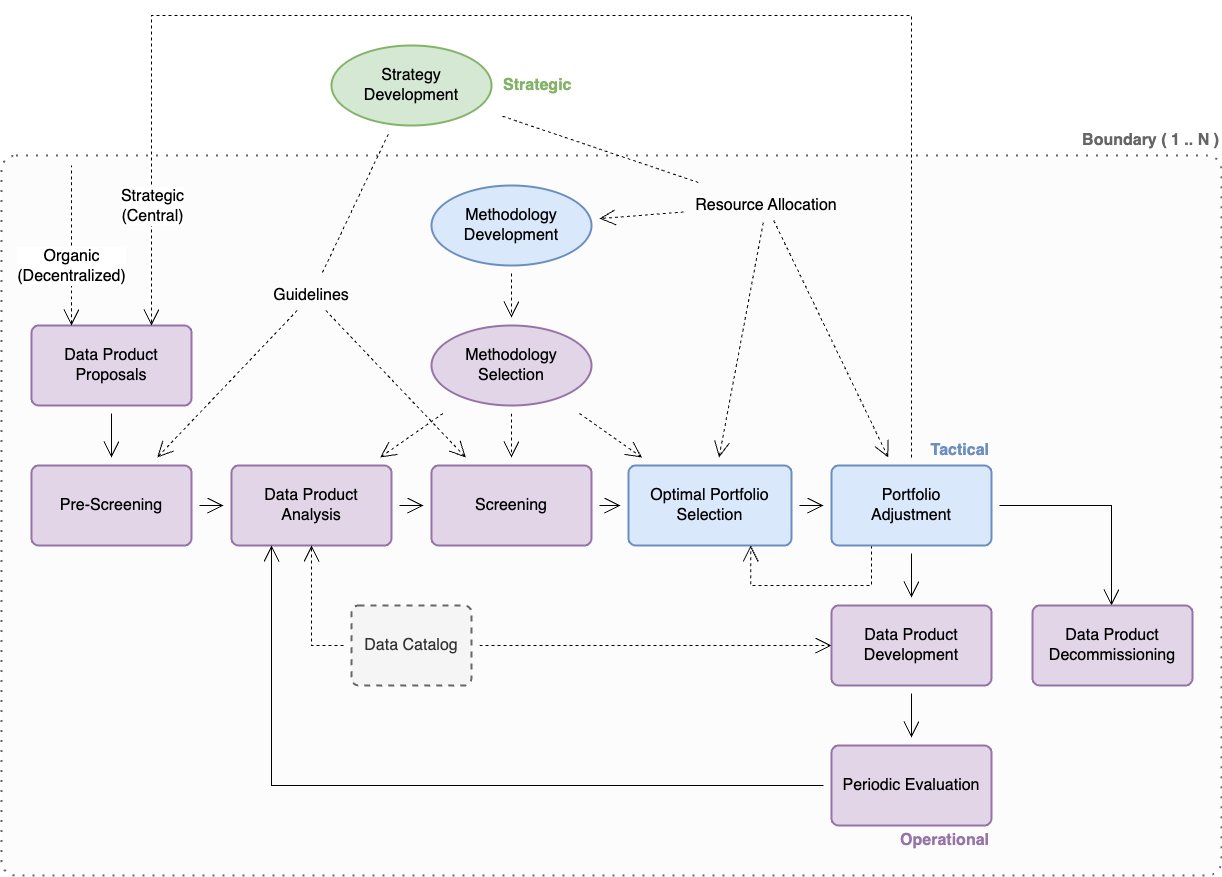
Boundaries
When reading this section, it’s important to bear in mind the impact of boundaries—although strategy development may be established as a global practice, other practices within DPPM must respect relevant organizational boundaries (which may be physical, geographical, operational, legal, commercial, or regulatory in nature). In some cases, the existence of boundaries may require some or all tactical and operational practices to be duplicated within each associated boundary. For example, an insurance company with a property and casualty legal entity in North America and a life entity in Germany may need to implement DPPM separately within each entity.
Strategy development
This practice deals with answering questions associated with the overall data mesh strategy, including the following:
- The overall scope (data domains, participating entities, and so on) of the data mesh
- The degree of freedom of participating entities in their definition and implementation of the data mesh (for example, a mesh of meshes vs. a single mesh)
- The distribution of responsibilities for activities and capabilities associated with the data mesh (degree of democratization)
- The definition and documentation of key performance indicators (KPIs) against which the data mesh should be governed (such as risk and value)
- The governance operating model (including this practice)
Key deliverables include the following:
- Organizational guidelines for operational processes around pre-screening and screening of data products
- Well-defined KPIs that guide methodology development and selection for practices like data product analysis, screening, and optimal portfolio selection
- Allocation of organizational resources (people, budget, time) to the implementation of tactical processes around methodology development, optimal portfolio selection, and portfolio adjustment
Key considerations
In this section, we discuss some key considerations for strategy development.
Data mesh structure

This diagram illustrates the analogous relationship between data products in a data mesh, and the structure of the mesh itself.
The following considerations relate to screening, data product analysis, and optimal portfolio selection.
- Trunk (core data products) – Core data products are those that are central to the organization’s ability to function, and from which the majority of other data products are derived. These may be data products consumed in the implementation of key business activities, or associated with critical processes such as regulatory reporting and risk management. Organizational governance for these data products typically favors availability and data accuracy over agility.
- Branch (cross-domain data products) – Cross-domain data products represent the most common cross-domain use cases for data (for example, joining customer data with product data). These data products may be widely used across business functions to support reporting and analytics, and—to a lesser extent—operational processes. Because these data products may consume a variety of sources, organizational governance may favor a balanced view on agility vs. reliability, accepting some degree of risk in return for being able to adapt to changes in data sources. Data product versioning can offer mitigation of risks associated with change.
- Leaf (everything else) – These are the myriad data products that may arise within a data mesh, either as permanent additions to support individual teams and use cases or as temporary data products to fill data gaps or support time-limited initiatives. Because the number of these data products may be high and risks are typically limited to a single process or a small part of the organization, organizational governance typically favors a light touch and may prefer to govern through guidelines and best practices, rather than through active participation in the data product lifecycle.
Data products vs. data definitions
The following figure illustrates how data definitions are defined and inherited throughout the lineage of data products.
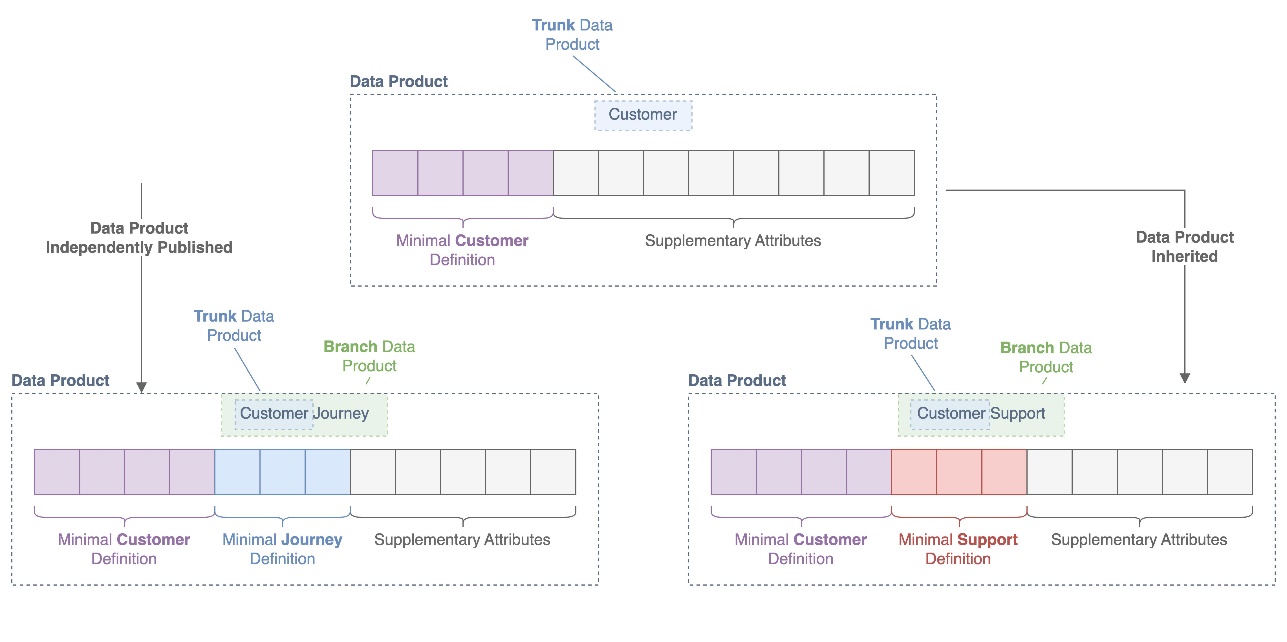
In a data mesh architecture, data products may inherit data from each other (one data product consumes another in its data pipeline) or independently publish data within (or related to) the same domain. For example, a customer data product may be inherited by a customer support data product, while another the customer journey data product may directly publish customer-relevant data from independent sources. When no standards are applied to how domain data attributes are used and published, data products even within the same data domain may lose interoperability because it becomes difficult or impossible to join them together for reporting or analytics purposes.
To prevent this, it can be useful to distinguish between data products and data definitions. Typically, organizations will select a single-threaded owner (often a data owner or steward, or a domain data owner or steward) who is responsible for defining minimal data definitions for common and reusable data entities within data domains. For example, a data owner responsible for the sales and marketing data domain may identify a customer data product as a reusable data entity within the domain and publish a minimal data definition that all producers of customer-relevant data must incorporate within their data products, to ensure that all data products associated with customer data are interoperable.
DPPM can assist in the identification and production of data definitions as part of its data product analysis activities, as well as enforce their incorporation as part of oversight of data product development.
Service management thinking
These considerations relate to data product analysis, periodic evaluation, and methodology selection.
Data products are services provided to the organization or externally to customers and partners. As such, it may make sense to adapt a service management framework like ITIL, in combination with the ITIL Maturity Model, for use in evaluating the fitness of data products for their scope and audience, as well as in describing the roles, processes, and acceptable technologies that should form the operating model for any data product.
At the operational level, the stakeholders required to implement each practice may change depending on the scope of the data product. For example, the release management practice for a core data product may require involvement of the data council, whereas the same practice for a team data product may only involve the team or functional head. To avoid creating decision-making bottlenecks, organizations should aim to minimize the number of stakeholders in each case and focus on single-threaded owners wherever possible.
The following table proposes a subset of capabilities and how they might be applied to data products of different scopes. Suggested target maturity levels, between 1 and 5, are included for each scope. (1= Initial, 5= Optimizing)
| Target Maturity | Data Product Scope. | |||
| 4 – 5 | 3 – 4 | 2 – 3 | 2 | |
| Capability | Core |
Cross-Domain |
Function / Team |
Personal |
| Information Security Management | X | X | X | X |
| Knowledge Management | X | X | X | . |
| Release Management | X | X | X | . |
| Service-Level Management | X | X | X | . |
| Measurement and Reporting | X | X | . | . |
| Availability Management | X | X | . | . |
| Capacity and Performance Management | X | X | . | . |
| Incident Management | X | X | . | . |
| Monitoring and Event Management | X | X | . | . |
| Service Validation and Testing | X | X | . | . |
Methodology development
This practice deals with the development of concrete, objective frameworks, metrics, and processes for the measurement of data product value and risk. Because the driving factors behind risk and value are not necessarily the same between products, it may be necessary to develop several methodologies or variants thereof.
Key deliverables include the following:
- Well-defined frameworks for measuring risk and value of data products, as well as for determining the optimal portfolio of data products
- Operationally feasible, measurable metrics associated with value and risk
Key considerations
A key consideration for assessing data products is that of consumer value or risk vs. uniqueness. The following diagram illustrates how value and risk of a data product are driven by its consumers.
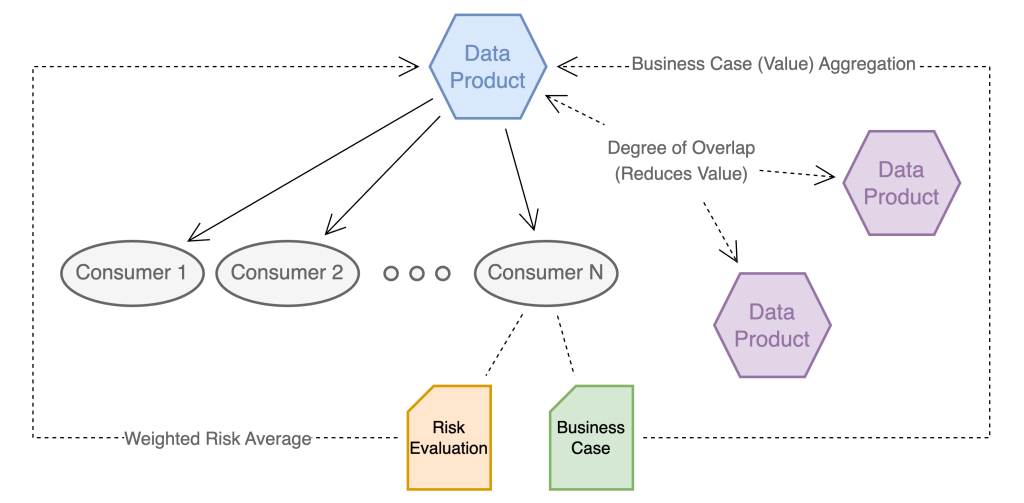
Data products don’t inherently present risk or add value, but rather indirectly pose—in an aggregated fashion—the risk and value created by their consumers.
In a consumer-centric value and risk model, governance of consumers ensures that all data use meets the following requirements:
- Is associated with a business case justifying the use of data (for example, new business, cost reduction through business process automation, and so on)
- Is regularly evaluated with reference to the risk associated with the use case (for example, regulatory reporting
The value and risk associated with the linked data products are then calculated as an aggregation. Where organizations already track use cases associated with data, either as part of data privacy governance or as a by-product of the access approval process, these existing systems and databases can be reused or extended.
Conversely, where data products overlap with each other, their value to the organization is reduced accordingly, because redundancies between data products represent an inefficient use of resources and increase organizational complexity associated with data quality management.
To ensure that the model is operationally feasible (see the key deliverables of methodology development), it may be sufficient to consider simple aggregations, rather than attempting to calculate value and risk attribution at a product or use case level.
Optimal portfolio selection
This practice deals with the determination of which combination of data products (existing, new, or potential) would best meet the organization’s current and known future needs. This practice takes input from data product analysis and data product proposals, as well as other enterprise architecture practices (for example, business architecture), and considers trade-offs between data-debt and time-to-value, as well as other considerations such as redundancy between data products to determine the optimal mix of permanent and temporary data products at any given point in time.
Because the number of data products in an organization may become significant over time, it may be useful to apply heuristics to the problem of optimal portfolio selection. For example, it may be sufficient to consider core and cross-domain data products (trunk and branches) during quarterly portfolio reviews, with other data products (leaves) audited on a yearly basis.
Key deliverables include the following:
- A target state definition for the data mesh, including all relevant data products
- An indication of organizational priorities for use by the portfolio adjustment practice
Key considerations

The following are key considerations regarding the data product half-life:
- Long-term or strategic data products – These data products fill a long-term organizational need, are often associated with key source systems in various domains, and anchor the overall data strategy. Over time, as an organization’s data mesh matures, long-term data products should form the bulk of the mesh.
- Time-bound data products – These data products fill a gap in data strategy and allow the organization to move on data opportunities until core data products can be updated. An example of this might be data products created and used in the context of mergers and acquisitions transactions and post-acquisition, to provide consistent data for reporting and business intelligence until mid-term and long-term application consolidation has taken place. Time-bound data products are considered as data-debt and should be managed accordingly.
- Purpose-driven data products – These data products serve a narrow, finite purpose. Purpose-driven data products may or may not be time-bound, but are characterized primarily by a strict set of consumers known in advance. Examples of this might include:
- Data products developed to support system-of-record harmonization between lines of business (for example, deduplication of customer records between insurance lines of business using separate CRM systems
- Data products created explicitly for the monitoring of other data products (data quality, update frequency, and so on)
Portfolio adjustment
This practice implements the feasibility analysis, planning and project management, as well as communication and organizational change management activities associated with changes to the optimal portfolio. As part of this practice, a gap analysis is conducted between the current and target data product portfolio, and a set of required actions and estimated time and effort prepared for review by the organization. During such a period, data products may be marked for development (new data products to fill a need), changes, consolidation (merging two or more data products into a single data product), or deprecation. Several iterations of optimal portfolio selection and portfolio adjustment may be required to find an appropriate balance between optimality and feasibility of implementation.
Key deliverables include the following:
- A gap analysis between the current and target data product portfolio, as well as proposed remediation activities
- High-level project plans and effort or budget assessments associated with required changes, for approval by relevant stakeholders (such as the data council)
Data product proposals
This practice organizes the collection and prioritization of requests for new, or changes to existing, data products within the organization. Its implementation may be adapted from or managed by existing demand management processes within the organization.
Key deliverables include a registry of demand against new or existing data products, including metadata on source systems, attributes, known use cases, proposed data product owners, and suggested organizational priority.
Methodology selection
This practice is associated with the identification and application of the most appropriate methodologies (such as value and risk) during data product analysis, screening, and optimal portfolio selection. The selection of an appropriate methodology for the type, maturity, and scope of a data product (or an entire portfolio) is a key element in avoiding either a “Kudzu” mesh or a “data desert.”
Key deliverables include reusable selection criteria for mapping methodologies to data products during data product analysis, screening, and optimal portfolio selection.
Pre-screening
This optional practice is primarily a mechanism to avoid unnecessary time and effort in the comparatively expensive practice of data product analysis by offering simple self-service applications of guidelines to the evaluation of data products. An example might include the automated approval of data products that fall under the classification of personal data products, requiring only attestation on the part of the requester that they will uphold the relevant portions of the guideline that governs such data products.
Key deliverables include tools and checklists for the self-service evaluation of data products against guidelines and automated registration of approved data products.
Data product analysis
This practice incorporates guidelines, methodologies, as well as (where available) metadata relating to data products (performance against SLOs, service management metrics, degree of overlap with other data products) to establish an understanding of the value and risk associated with individual data products, as well as gaps between current and target capability maturities, and compliance with published product definitions and standards.
Key deliverables include a summary of findings for a particular data product, including scores for relevant value, risk, and maturity metrics, as well as operational gaps requiring remediation and recommendations on next steps (repair, enhance, decommission, and so on).
Screening
This optional practice is a mechanism to reduce complexity in optimal portfolio selection by ensuring the early removal of data products from consideration that fail to meet value or risk targets, or have been identified as redundant to other data products already available in the organization.
Key deliverables include a list of data products that should be slated for removal (direct-to-decommissioning).
Data product development
This practice is not performed directly under DPPM, but is managed in part by the portfolio adjustment practice, and may be governed by standards that are developed as part of DPPM. In the context of DPPM, this practice is primarily associated with ensuring that data products are developed according to the specifications agreed as part of portfolio adjustment.
Key deliverables include project management and software or service development deliverables and artefacts.
Data product decommissioning
This practice manages the decommissioning of data products and the migration of affected consumers to new or other data products where relevant. Unmanaged decommissioning of data products, especially those with many downstream consumers, can threaten the stability of the entire data mesh, as well as have significant consequences to business functions.
Key deliverables include a decommissioning plan, including stakeholder assessment and sign-off, timelines, migration plans for affected consumers, and back-out strategies.
Periodic evaluation
This practice manages the calendar and implementation of periodic reviews of the data mesh, both in its entirety as well as at the data product level, and is primarily an exercise in project management.
Key deliverables include the following:
- yearly review calendar, published and made available to all data product owners and affected stakeholders
- Project management deliverables and artefacts, including evidence of evaluations having been performed against each data product
Technology
Although most practices within DPPM don’t rely heavily on technology and automation, some key supporting applications and services are required to implement DPPM effectively:
- Data catalog – Core to the delivery of DPPM is the organizational data catalog. Beyond providing transparency into what data products exist within an organization, a data catalog can provide key insights into data lineage between data products (key to the implementation of portfolio adjustment) and adoption of data products by the organization. The data catalog can also be used to capture and make available both the documented as well as the realized SLO for any given data product, and—through the use of a business glossary—assist in the identification of redundancy between data products.
- Service management – Service management solutions (such as ServiceNOW) used in the context of data product management offer important insights into the fitness of data products by capturing and tracking incidents, problems, requests, and other metrics against data products.
- Demand management – A demand management solution supports self-service implementation and automation of data product proposal and pre-screening activities, as well as prioritization activities associated with selection and development of data products.
Conclusion
Although this post focused on implementing DPPM in the context of a data mesh, this capability—like data product thinking—is not exclusive to data mesh architectures. The practices outlined here can be practiced at any scale to ensure that the production and use of data within the organization is always in line with its current and future needs, that governance is implemented in a consistent way, and that the organization can have Bonsai, not Kudzu.
For more information about data mesh and data management, refer to the following:
In upcoming posts, we will cover other aspects of data mesh operating models, including data mesh supervision and service management models for data product owners.
About the Authors
 Maximilian Mayrhofer is a Principal Solutions Architect working in the AWS Financial Services EMEA Go-to-Market team. He has over 12 years experience in digital transformation within private banking and asset management. In his free time, he is an avid reader of science fiction and enjoys bouldering.
Maximilian Mayrhofer is a Principal Solutions Architect working in the AWS Financial Services EMEA Go-to-Market team. He has over 12 years experience in digital transformation within private banking and asset management. In his free time, he is an avid reader of science fiction and enjoys bouldering.
 Faris Haddad is the Data & Insights Lead in the AABG Strategic Pursuits team. He helps enterprises successfully become data-driven.
Faris Haddad is the Data & Insights Lead in the AABG Strategic Pursuits team. He helps enterprises successfully become data-driven.






